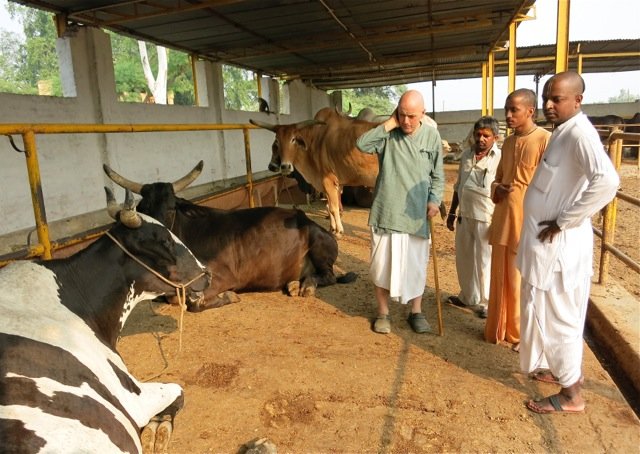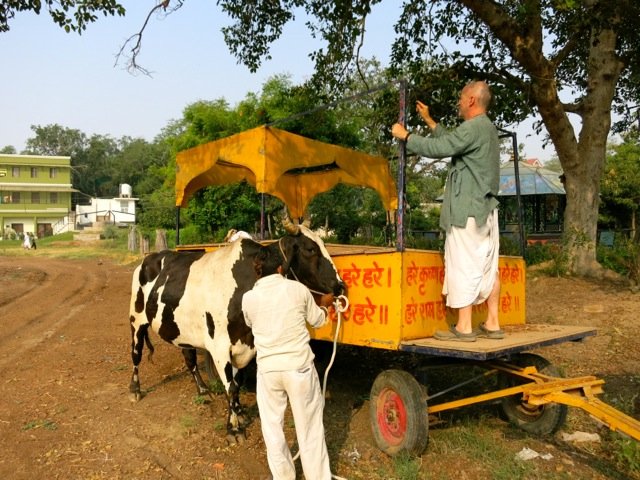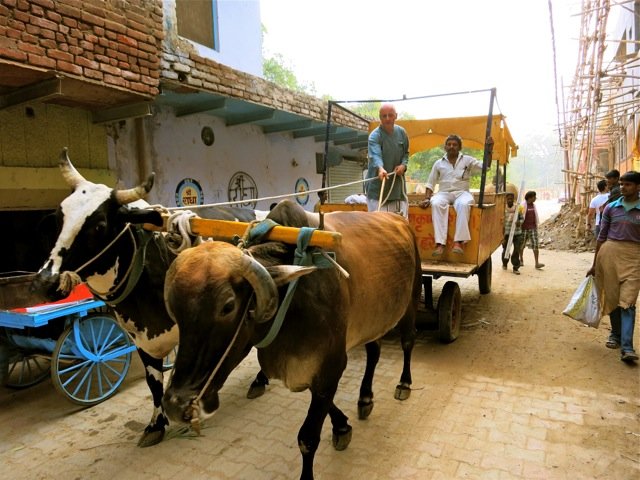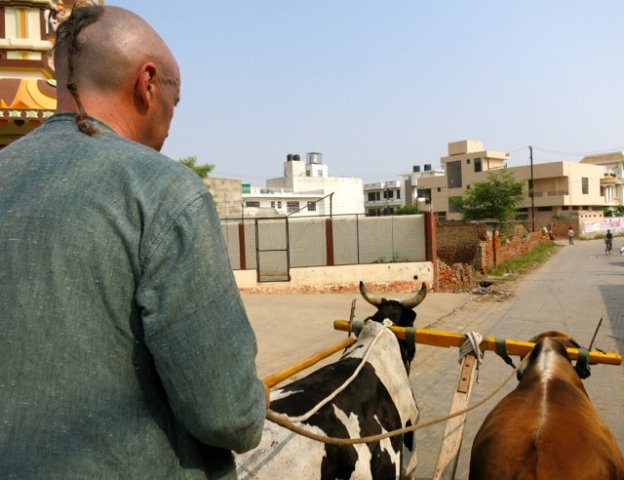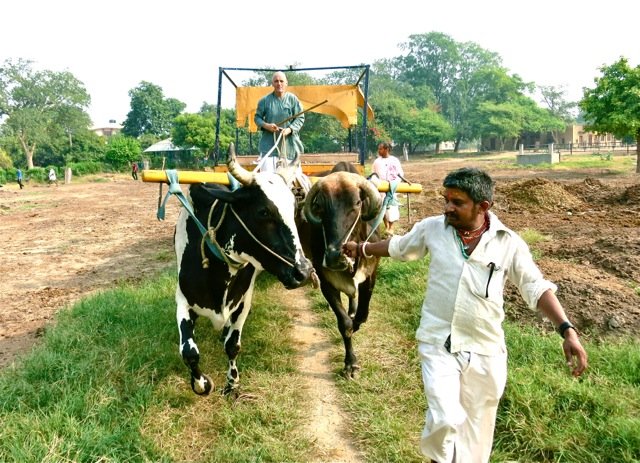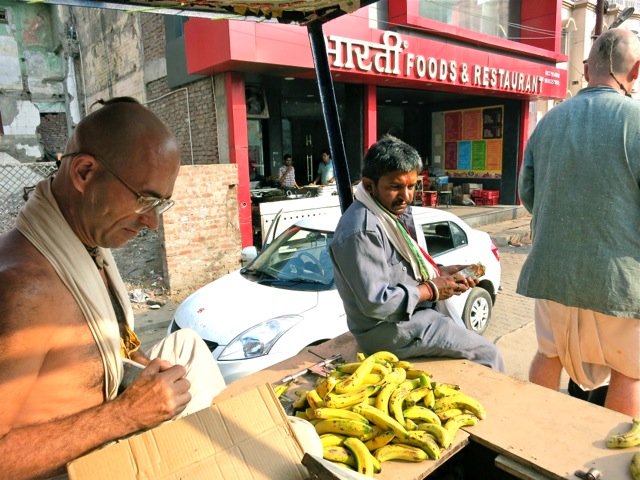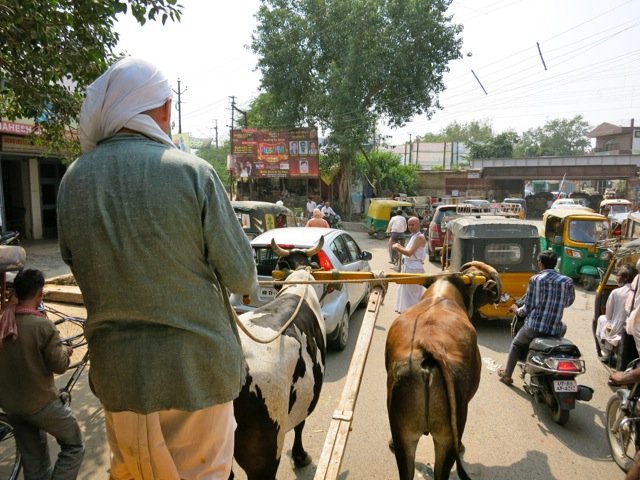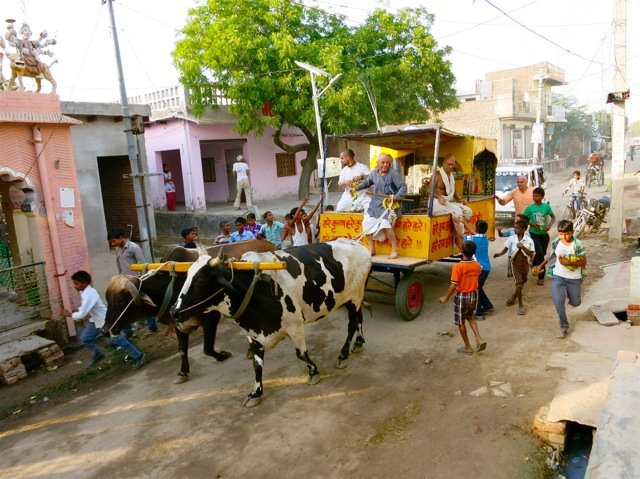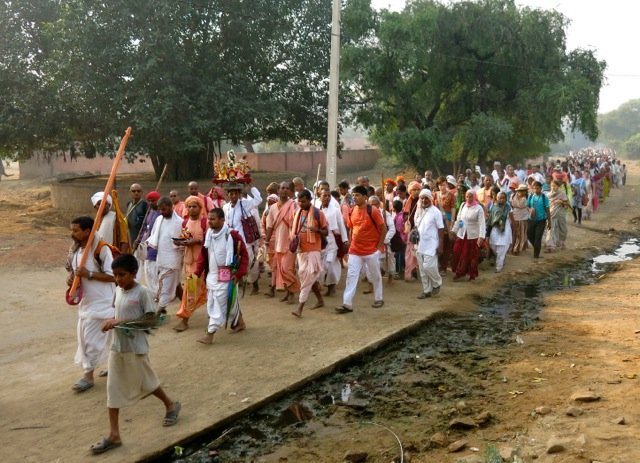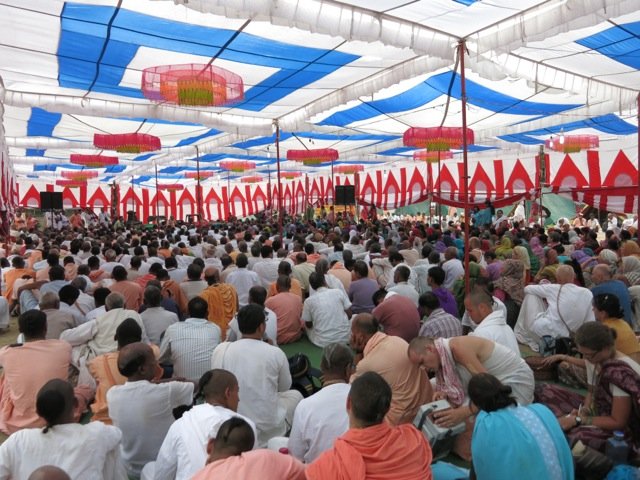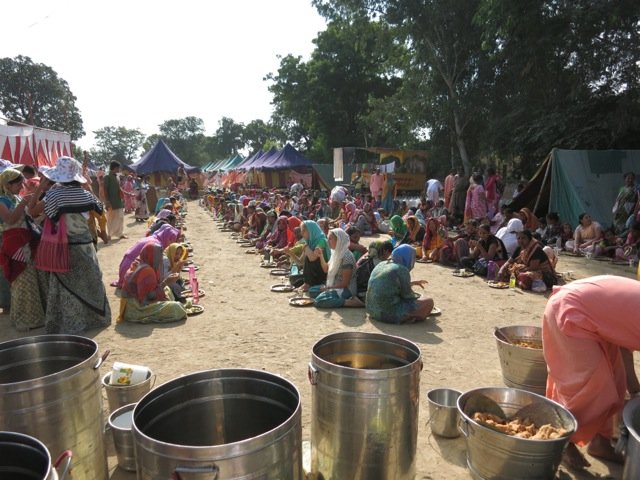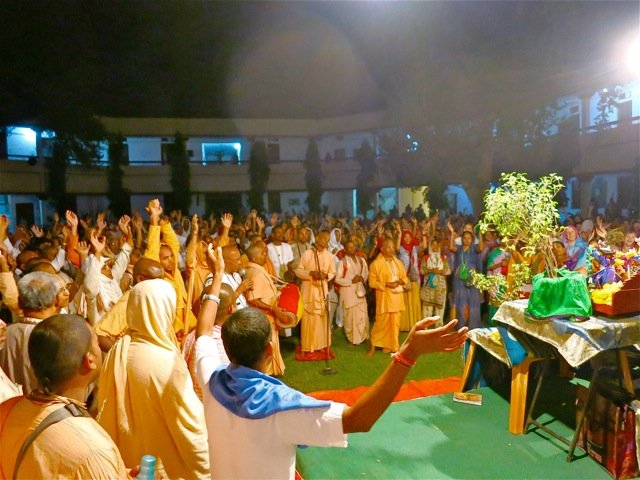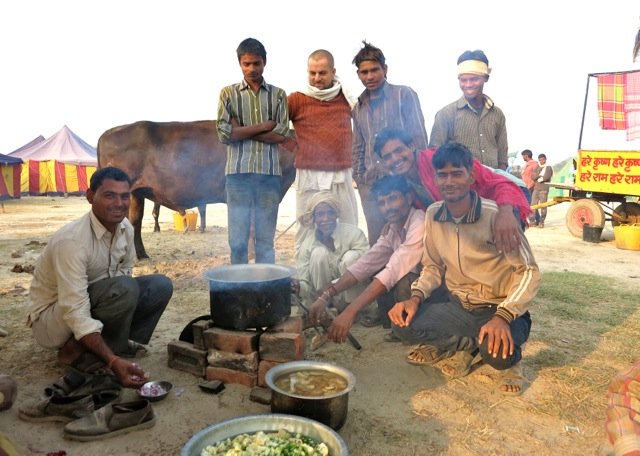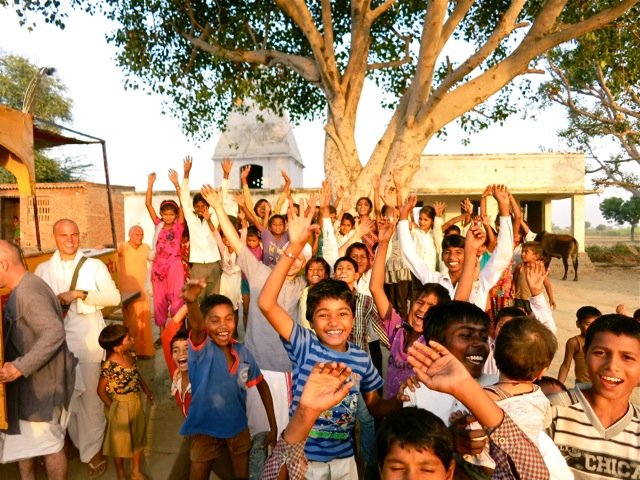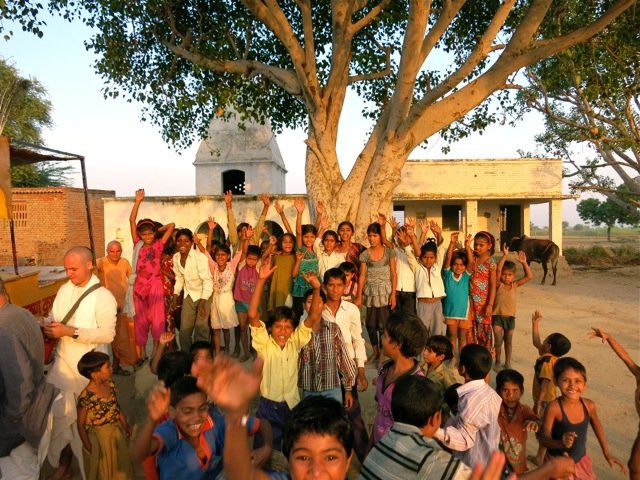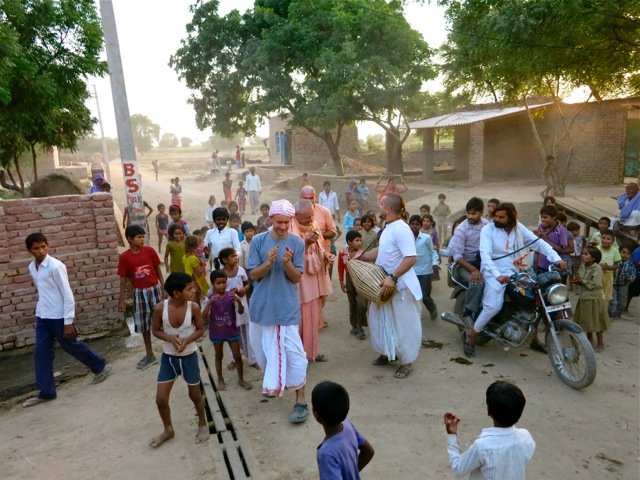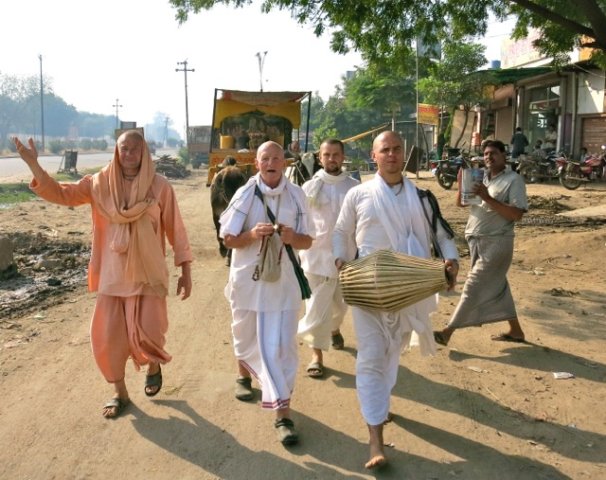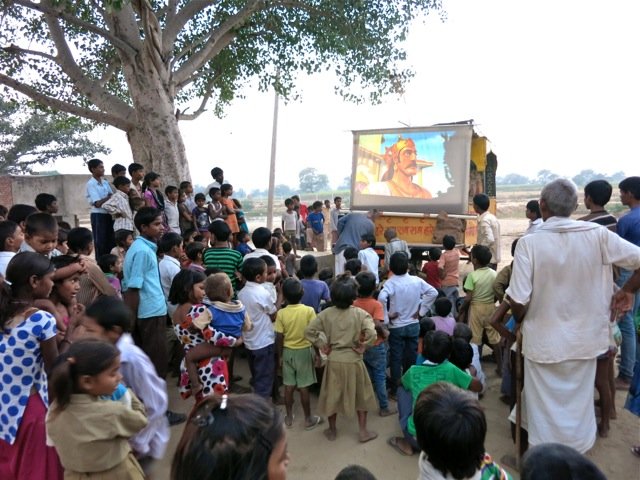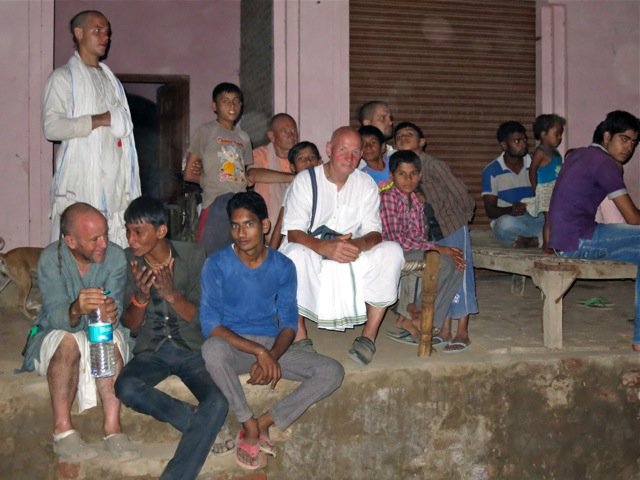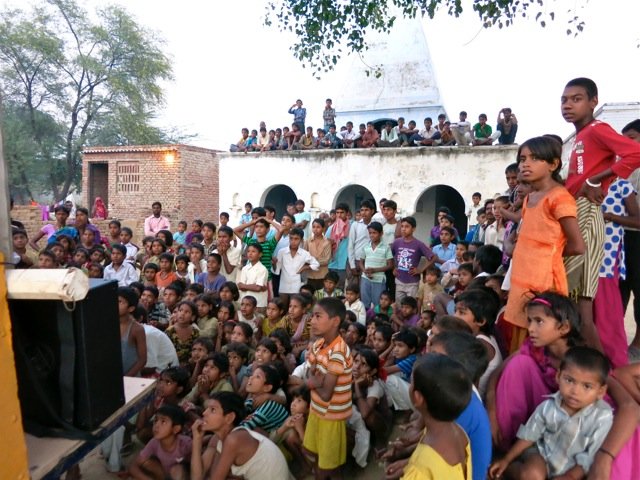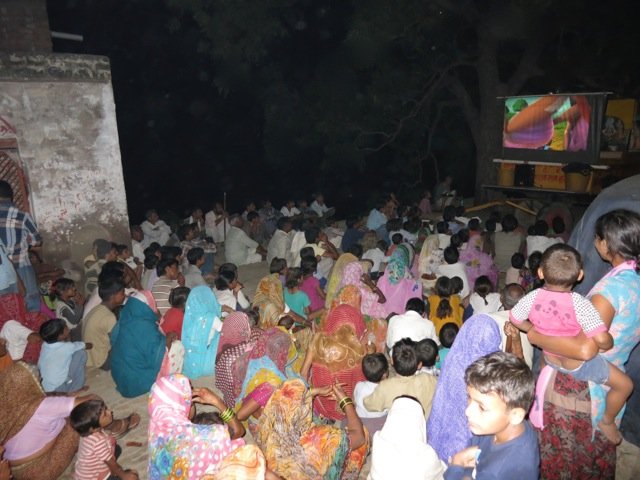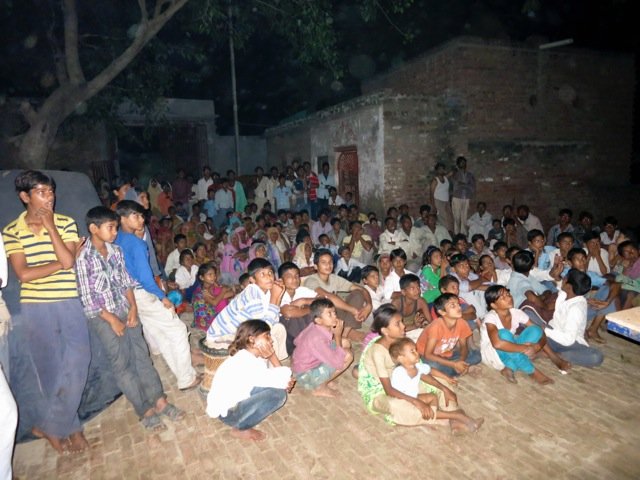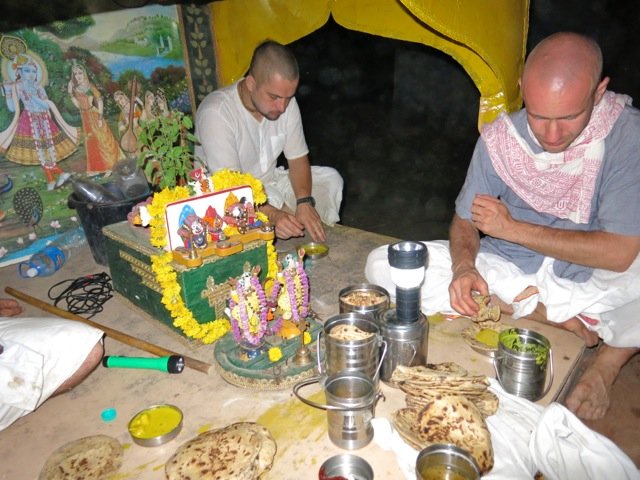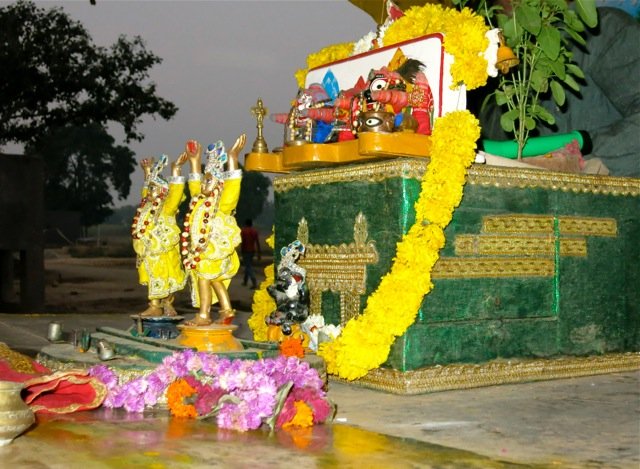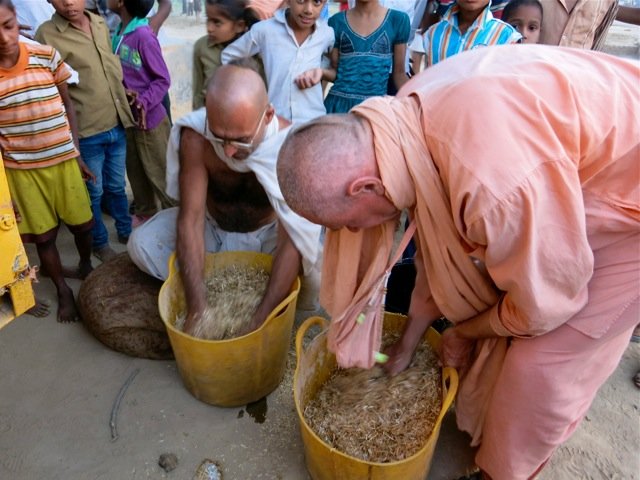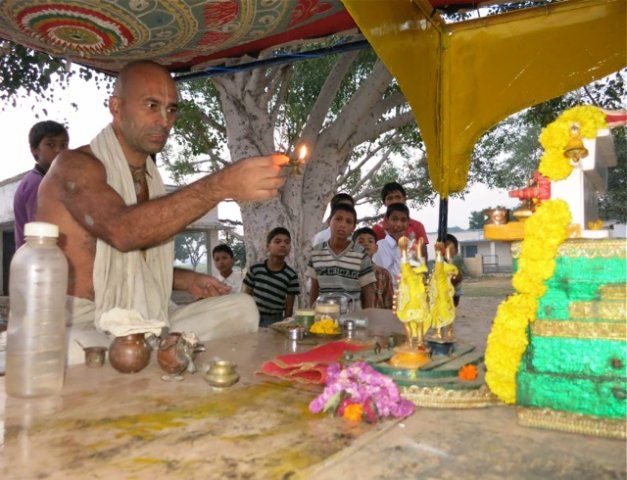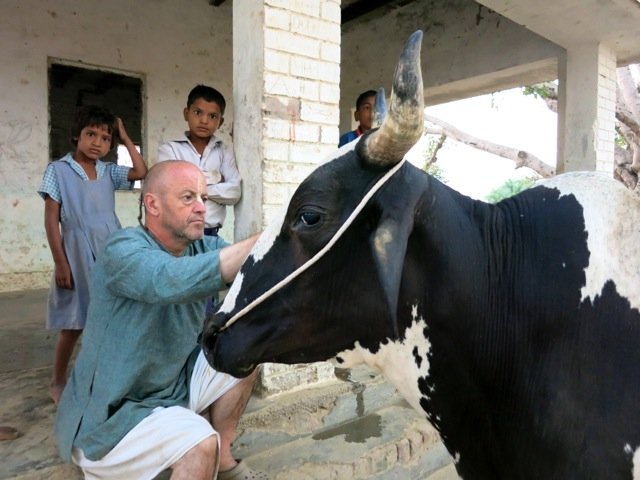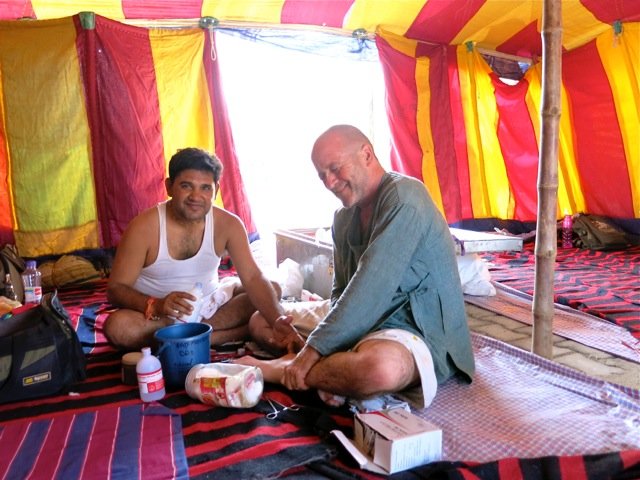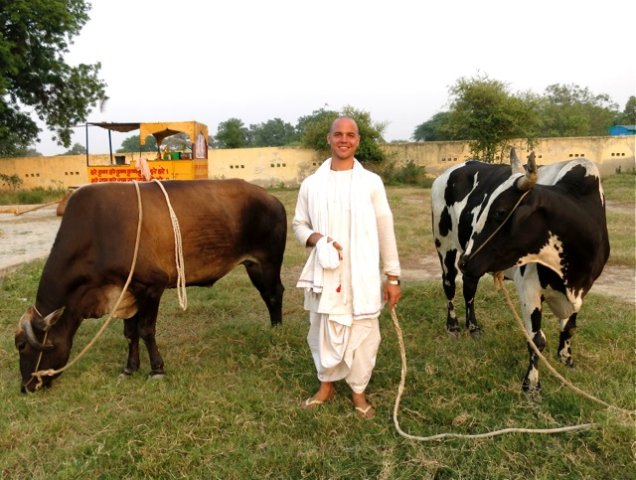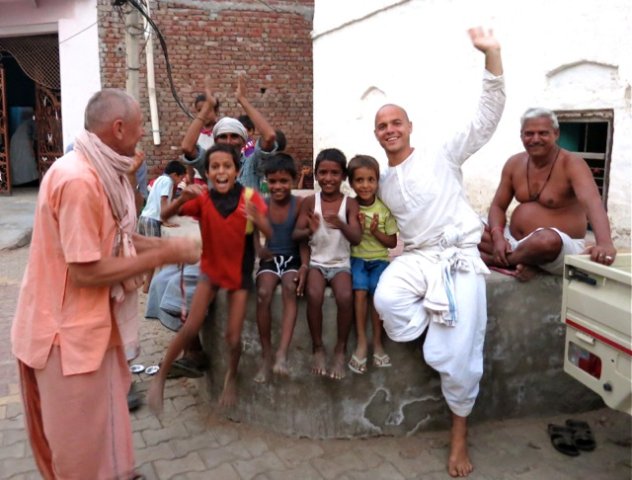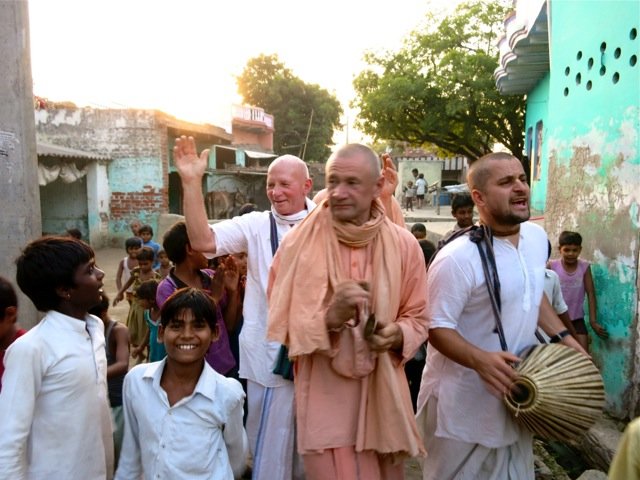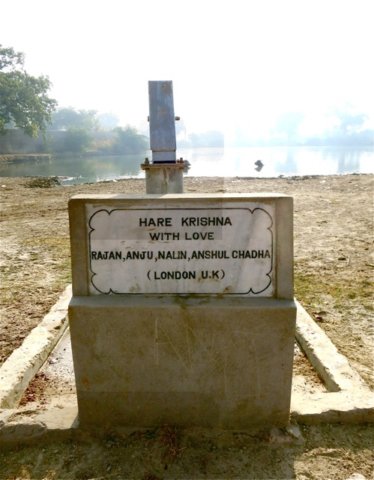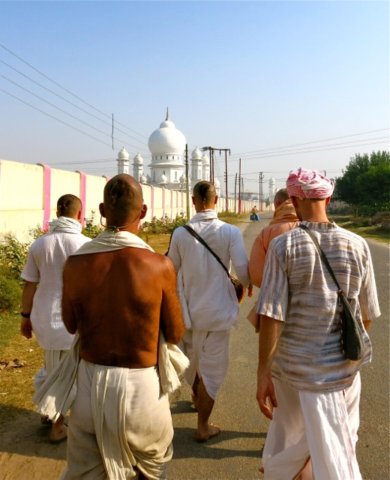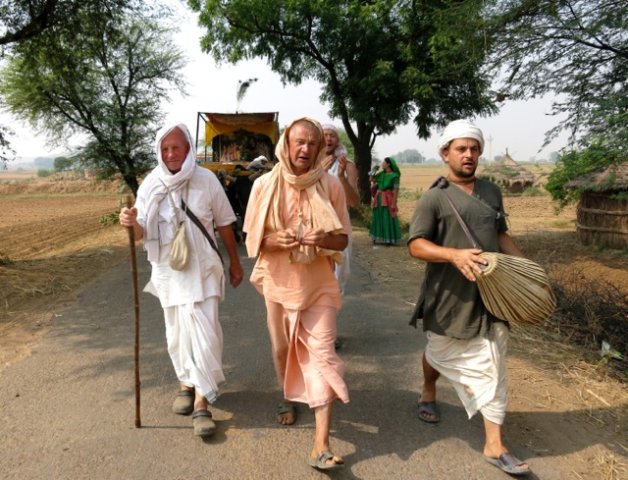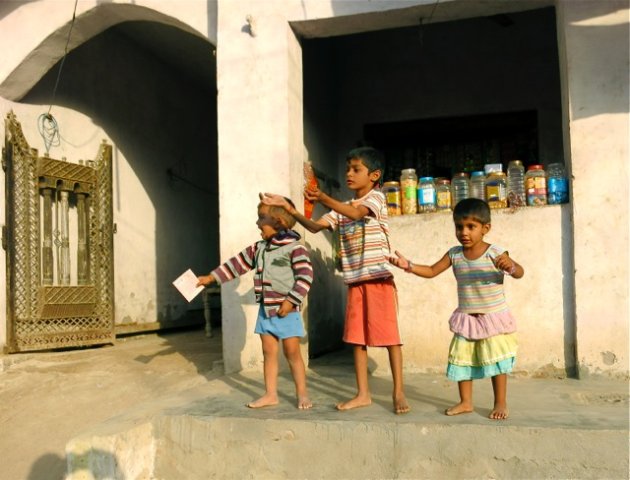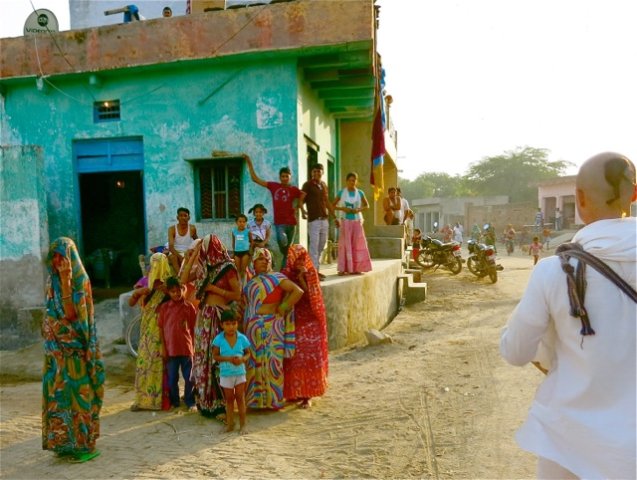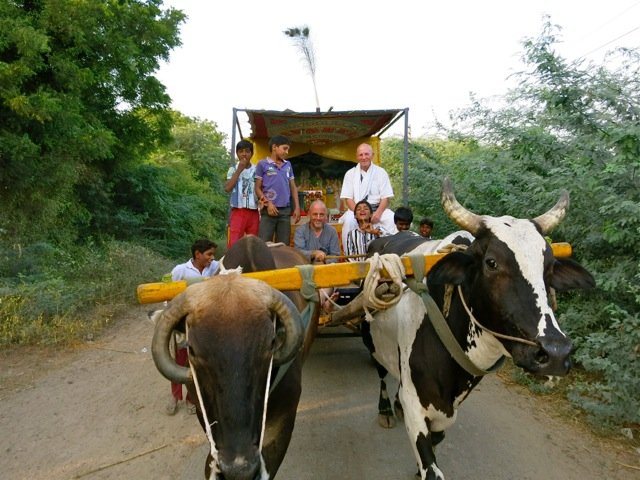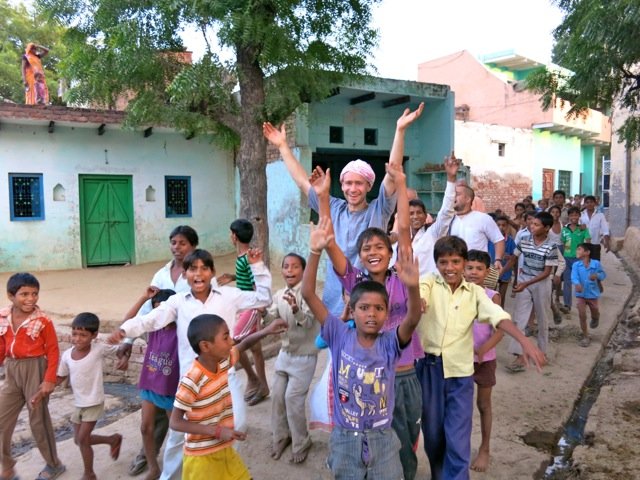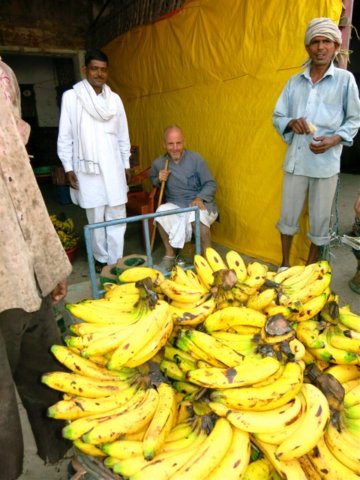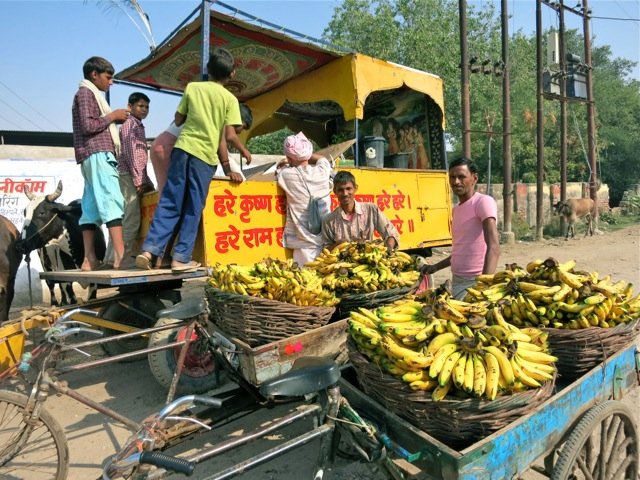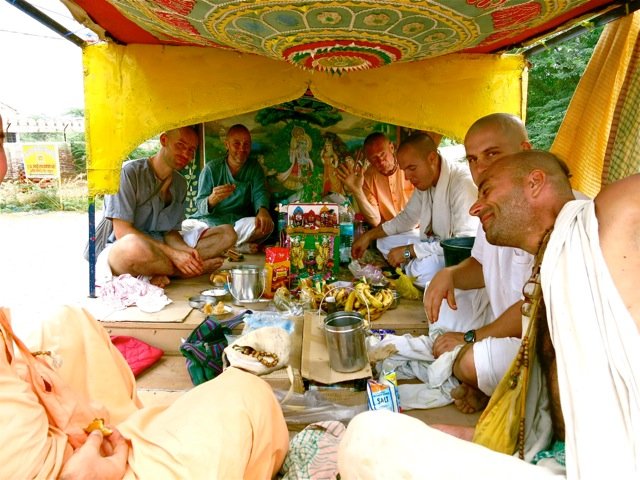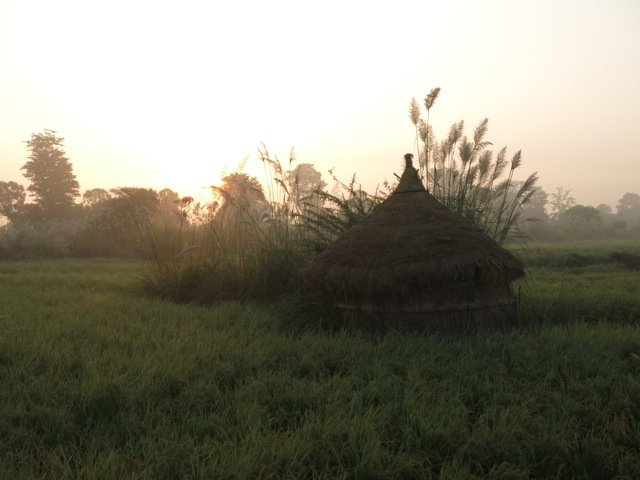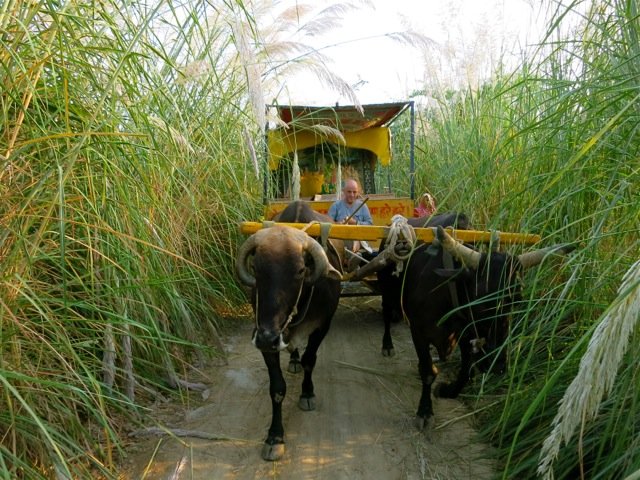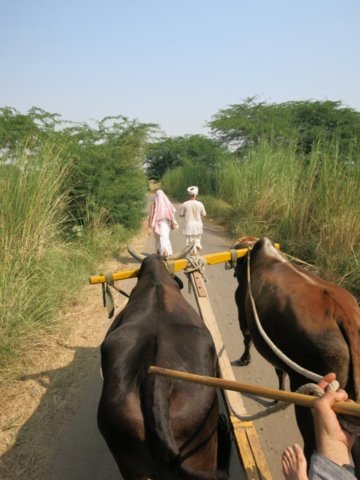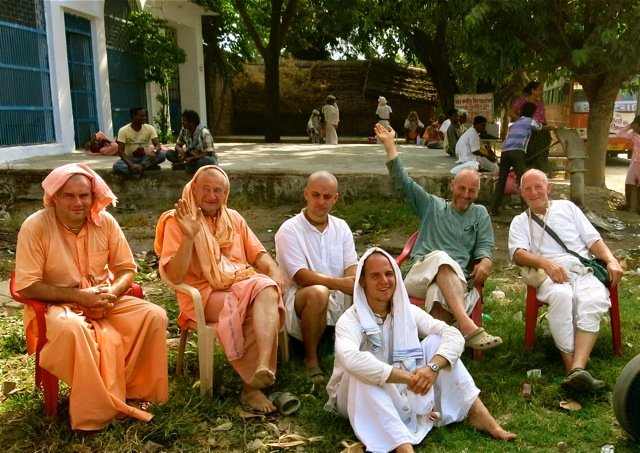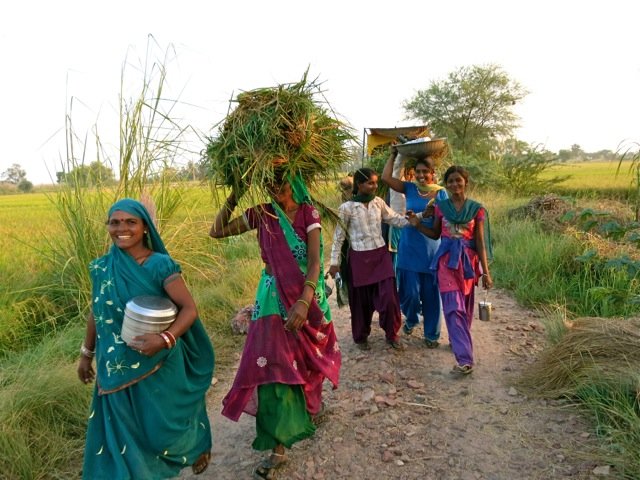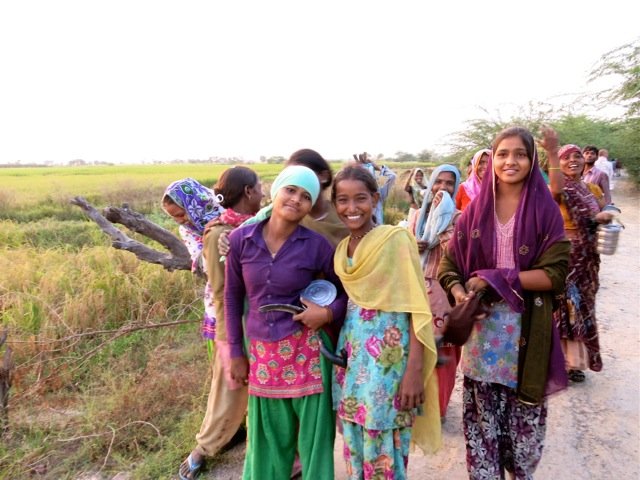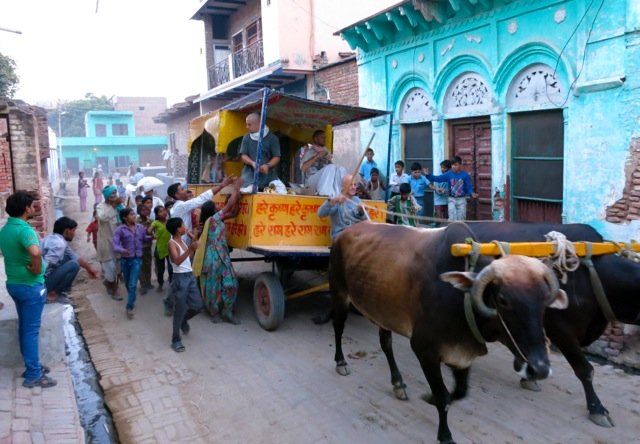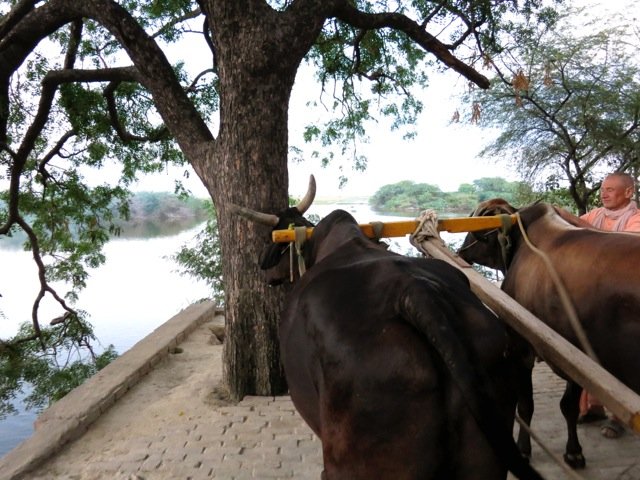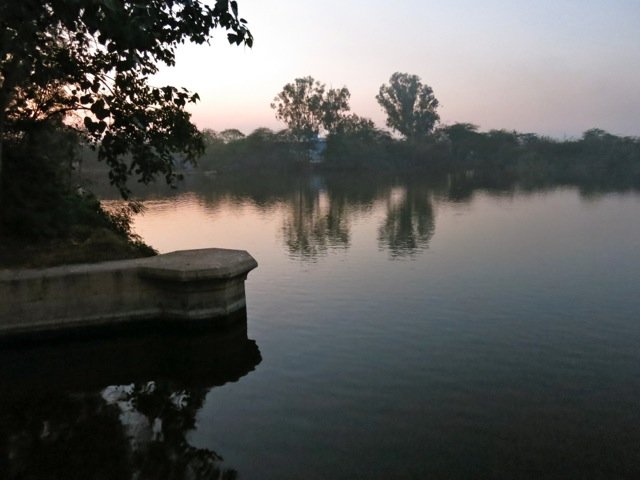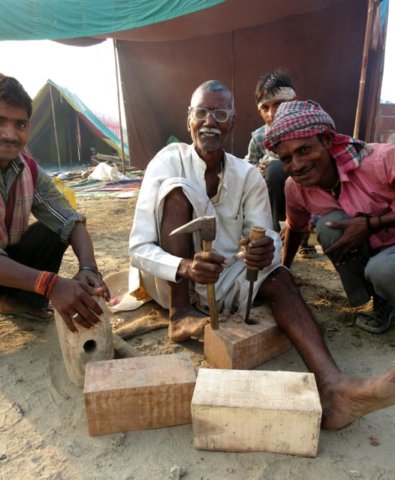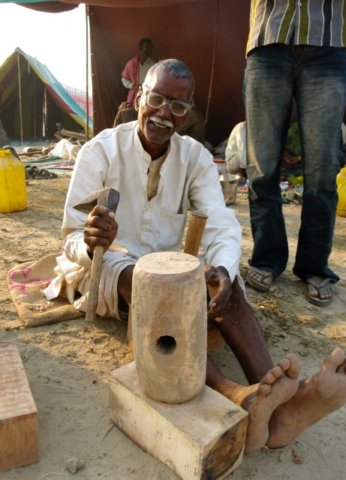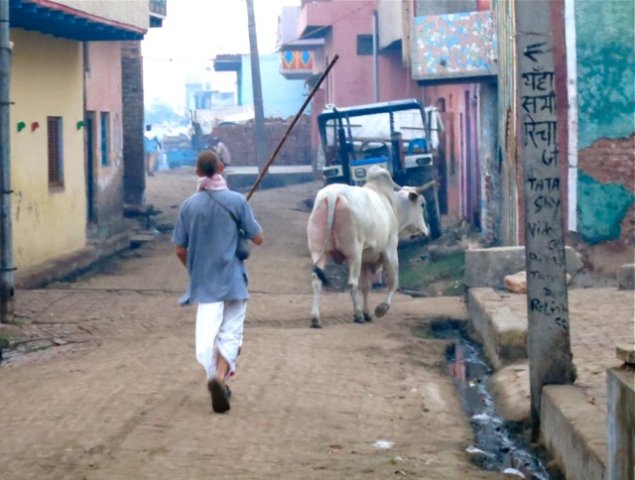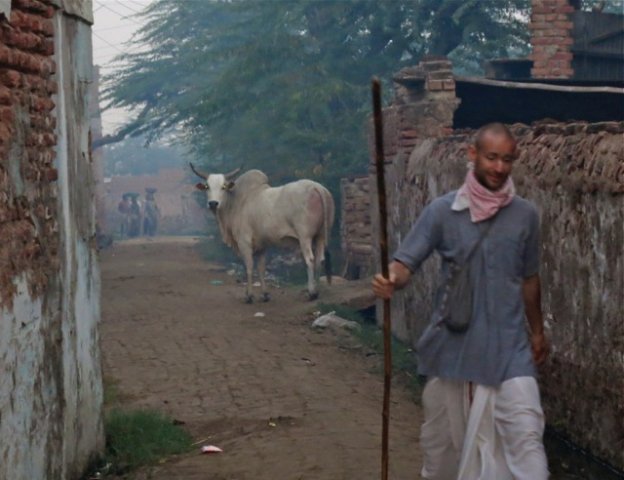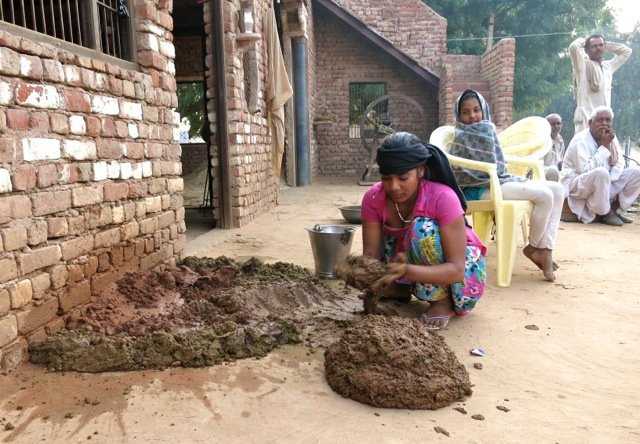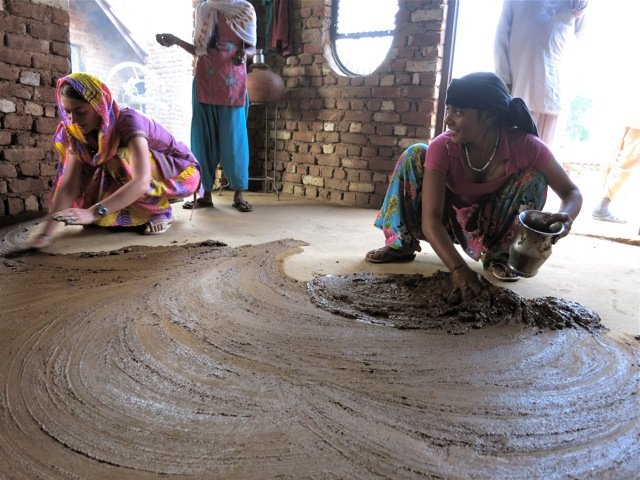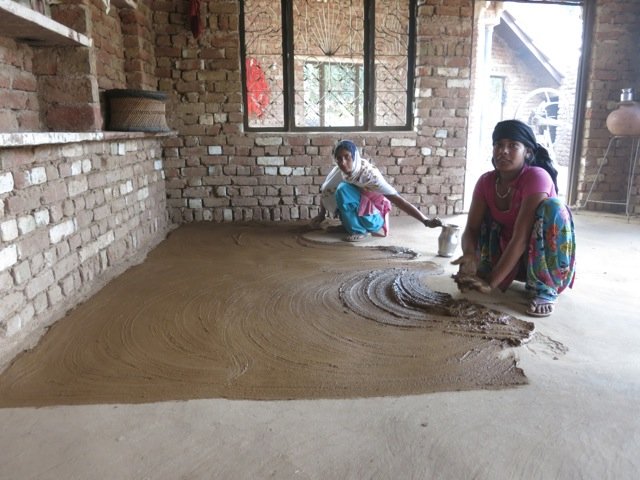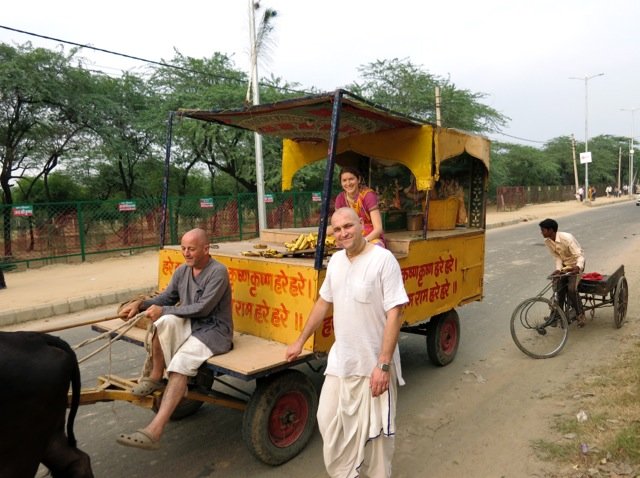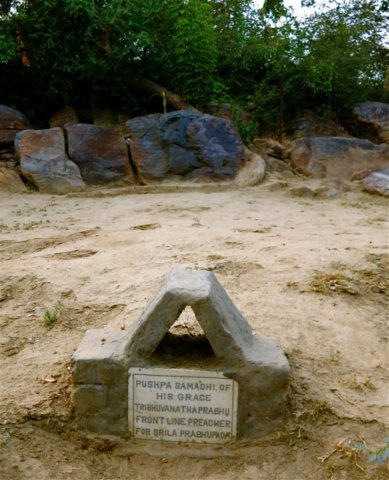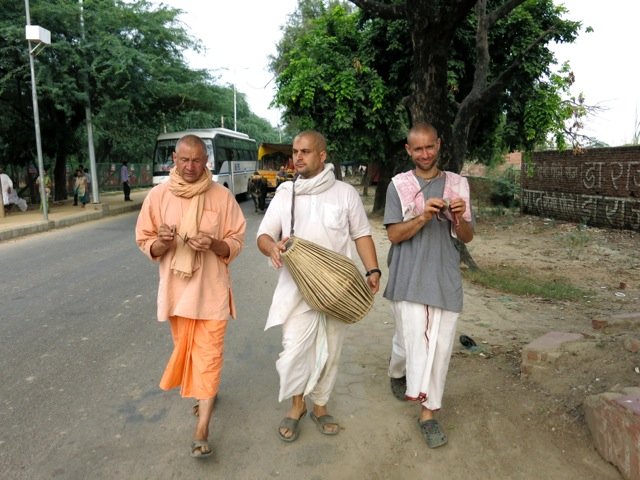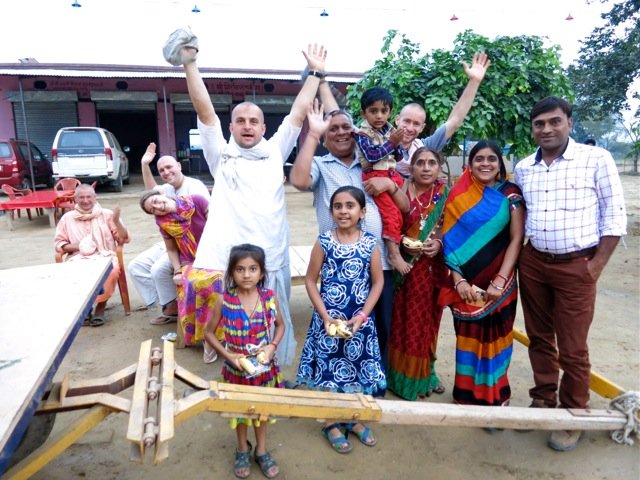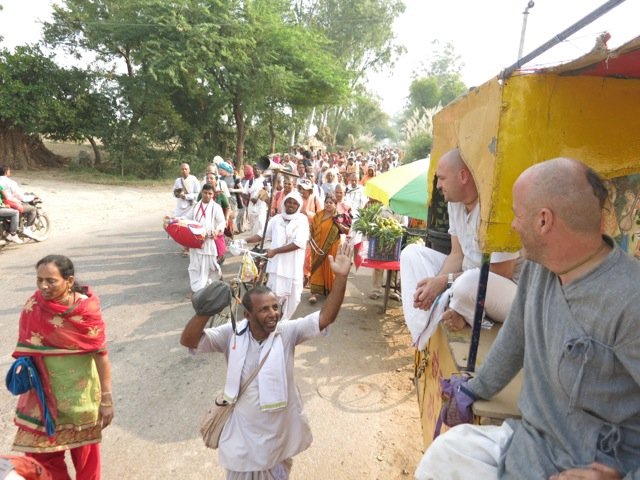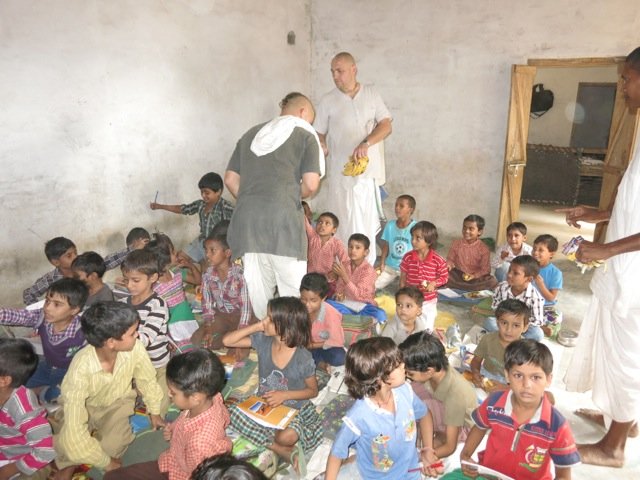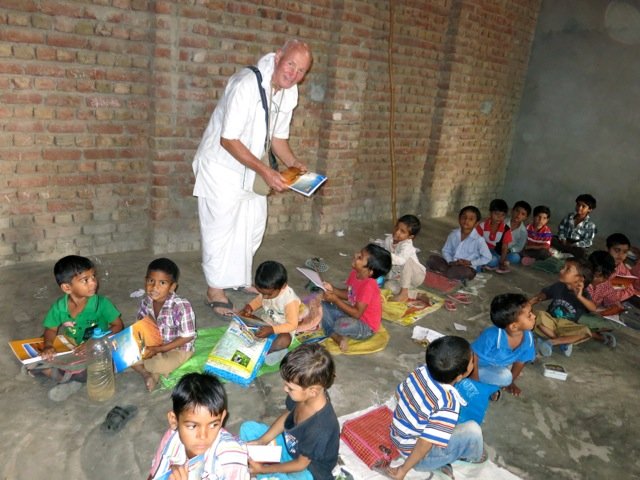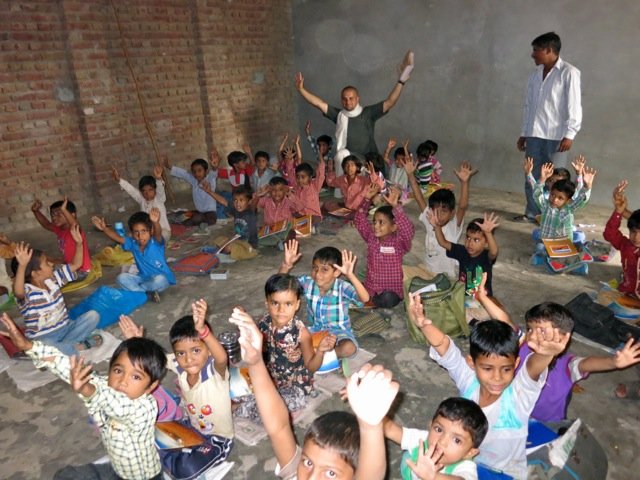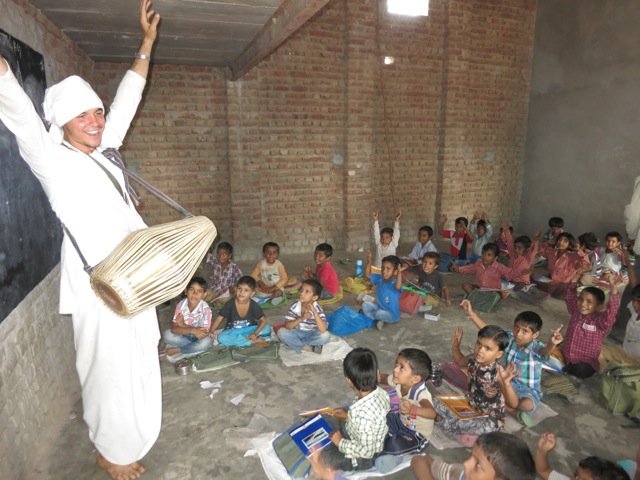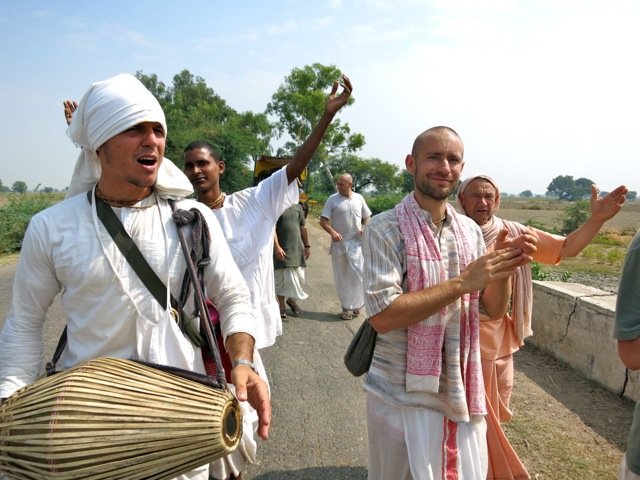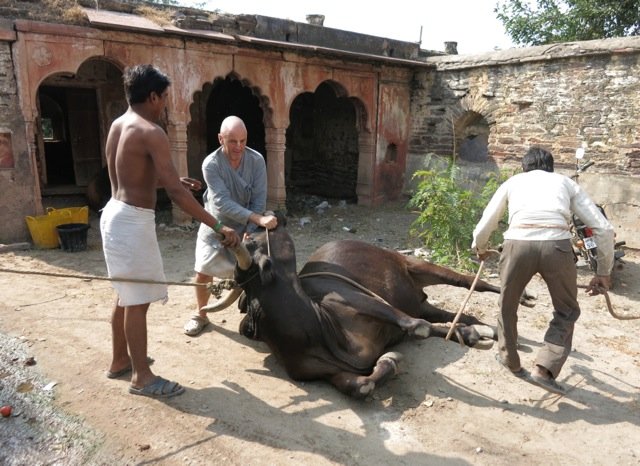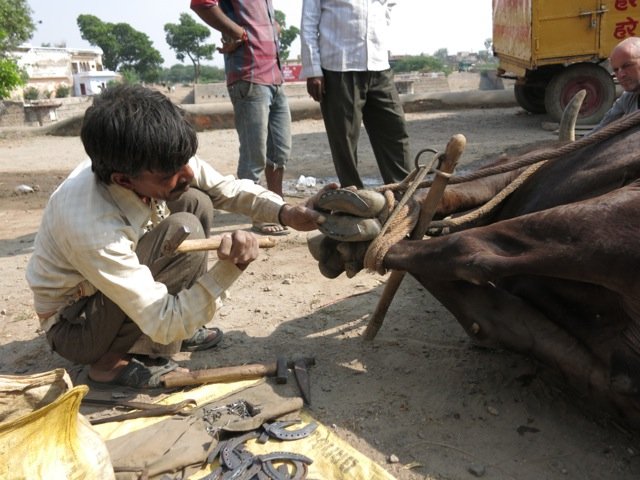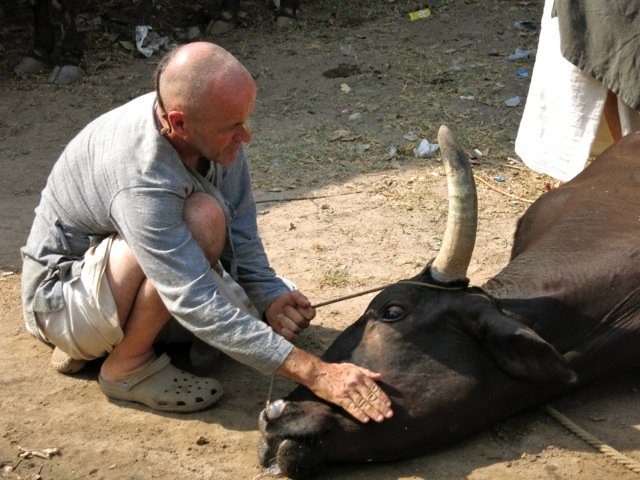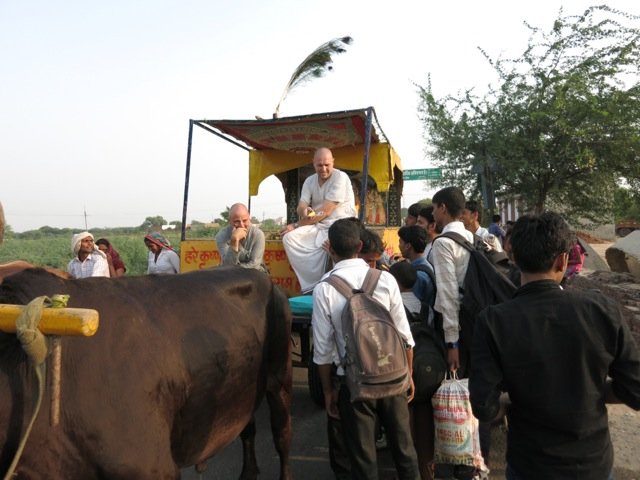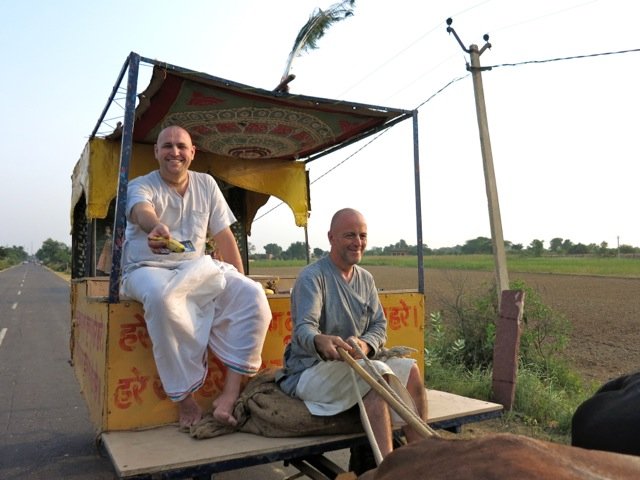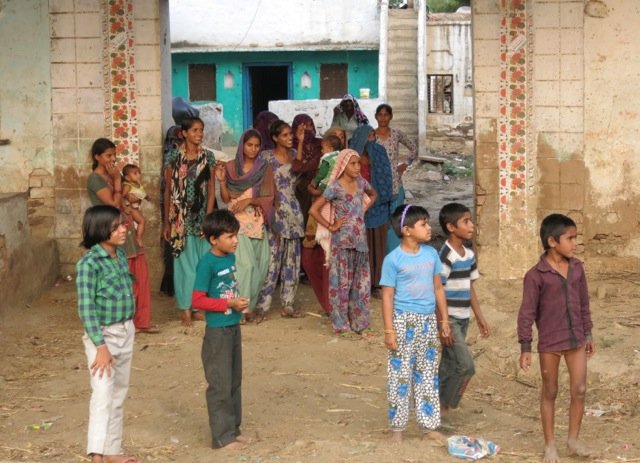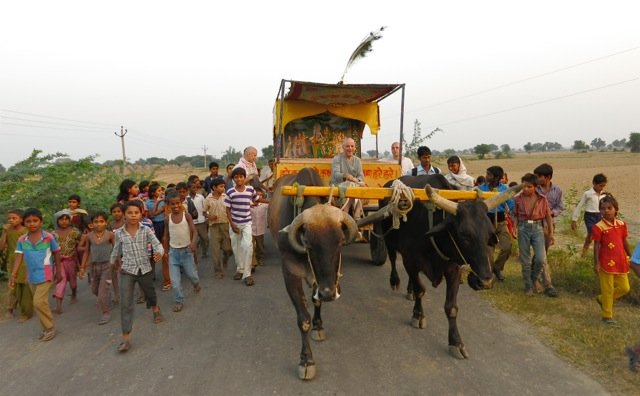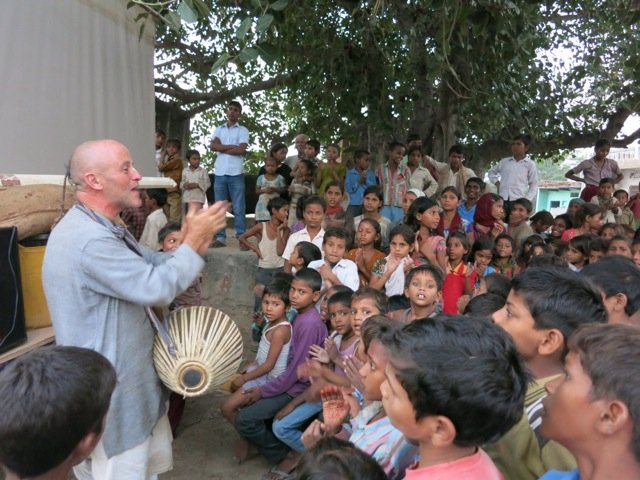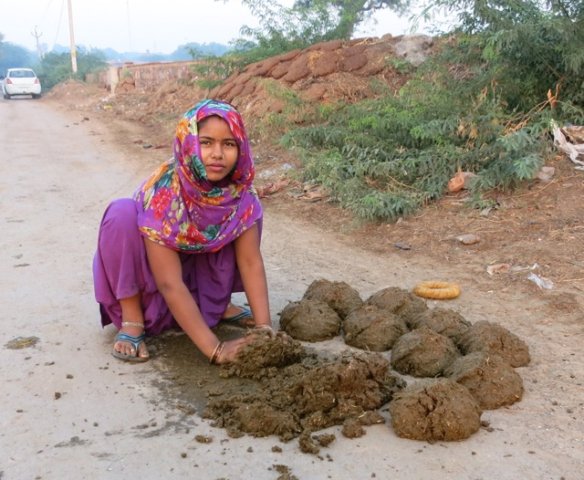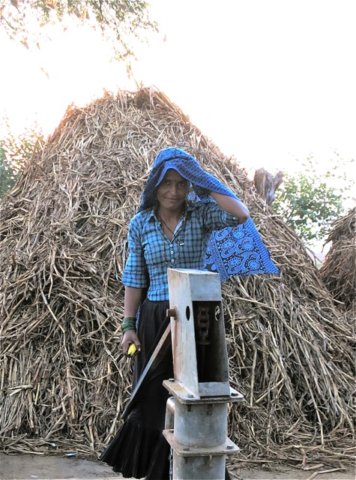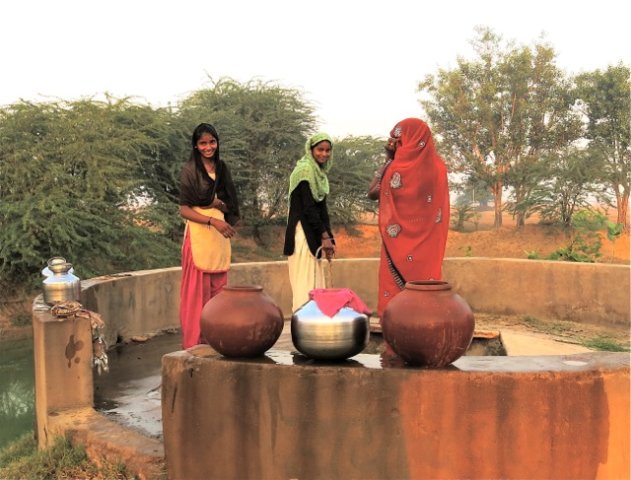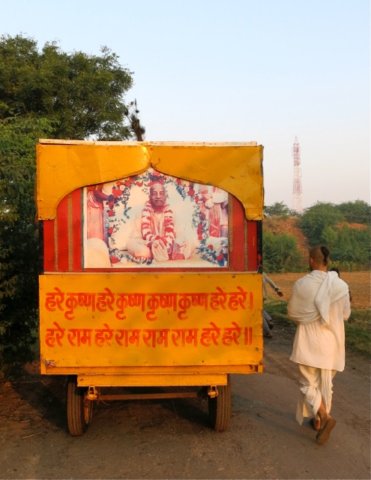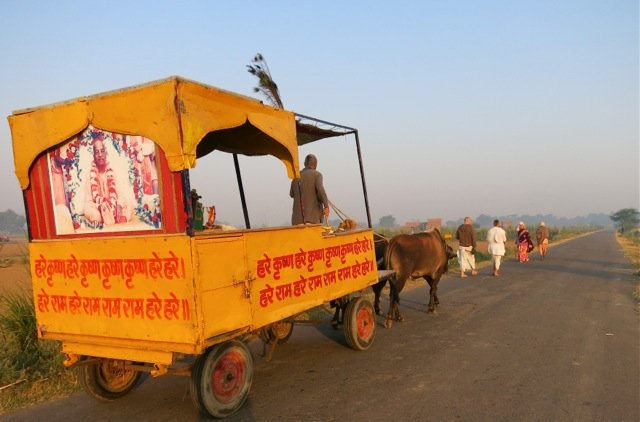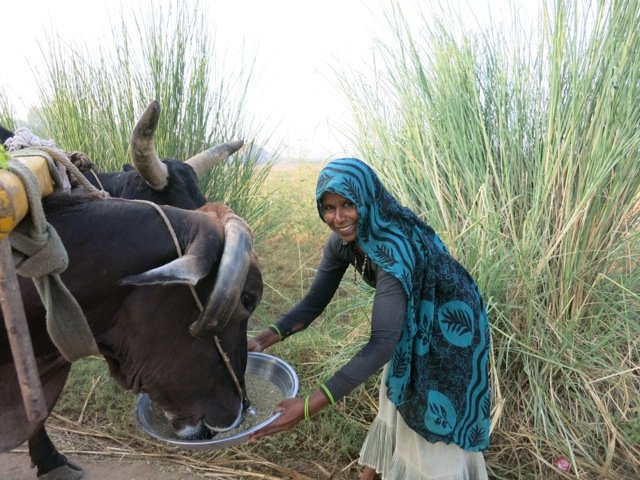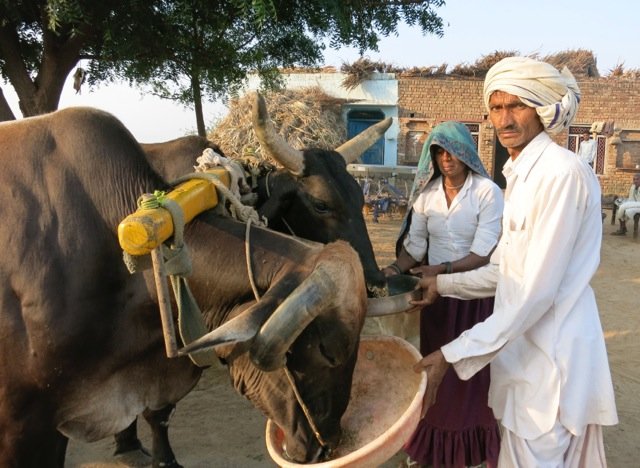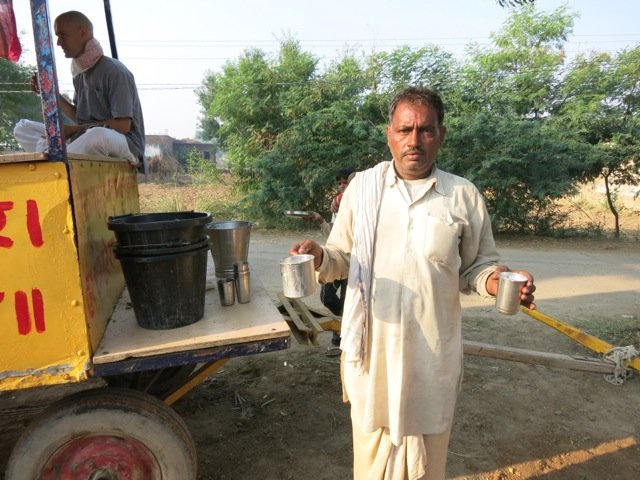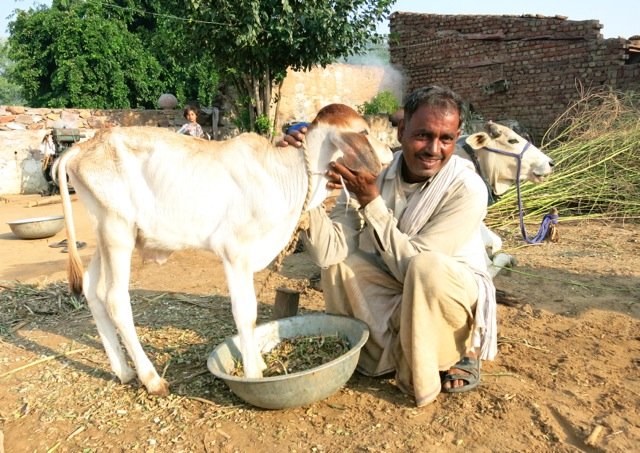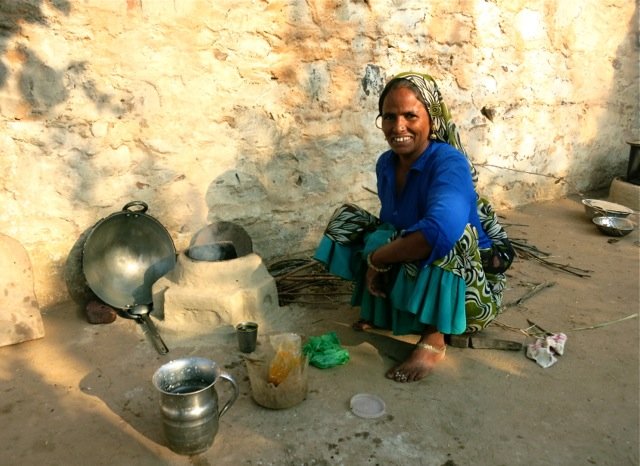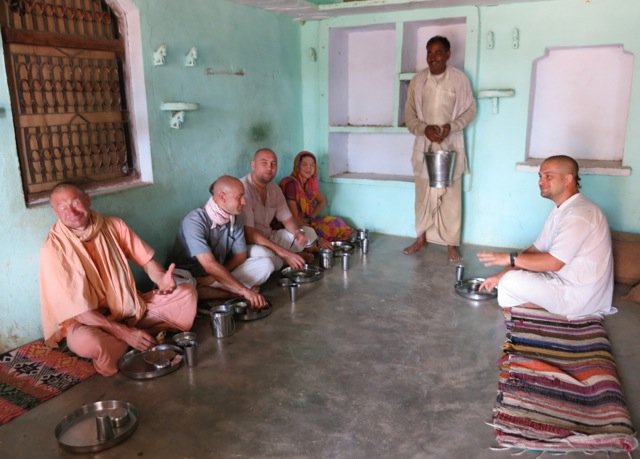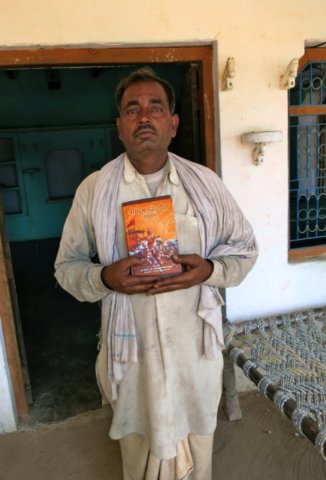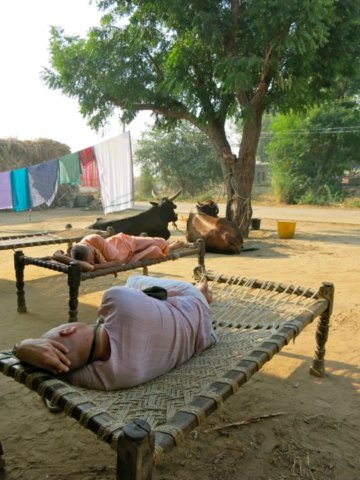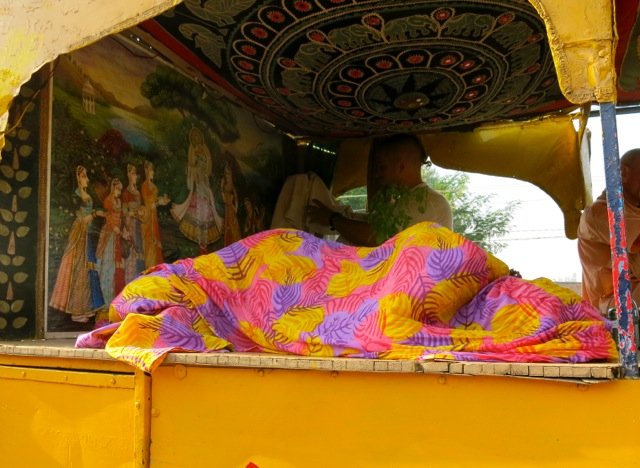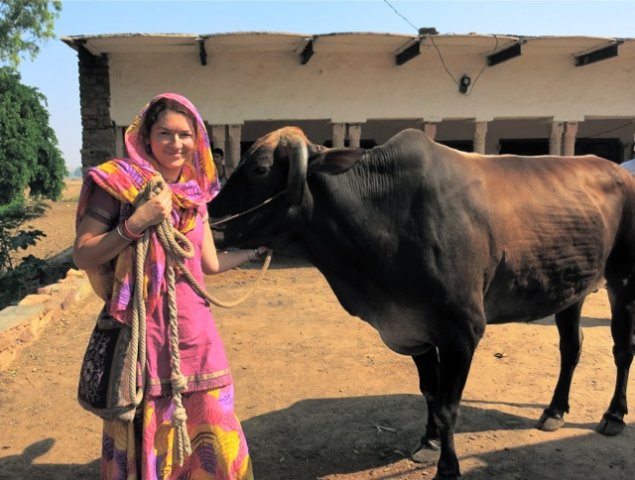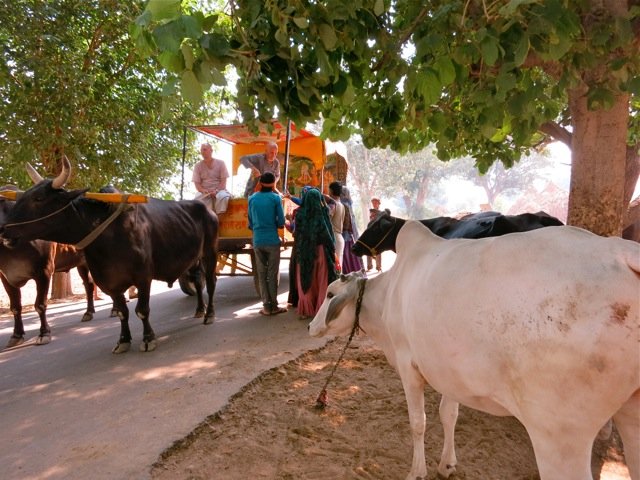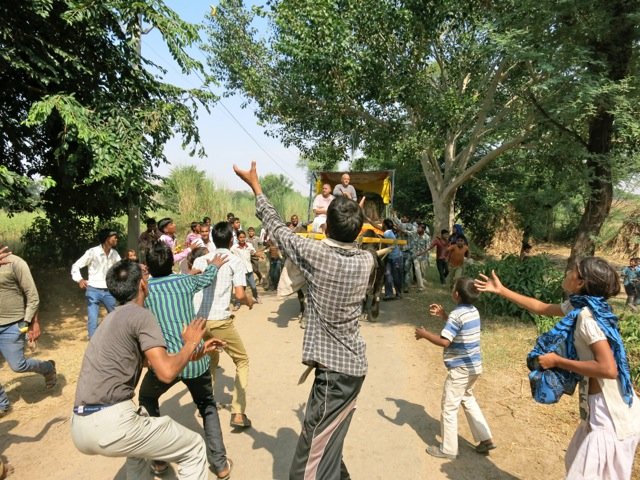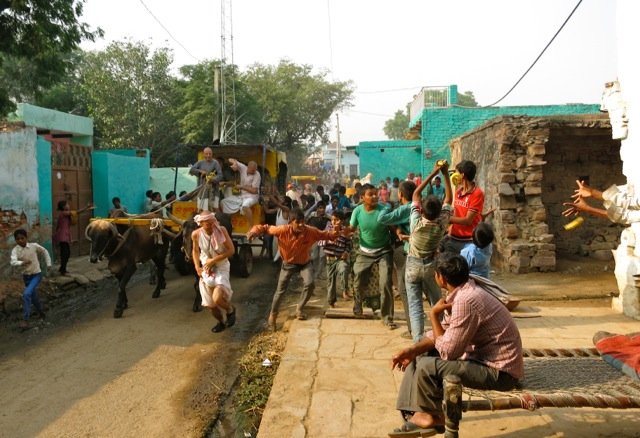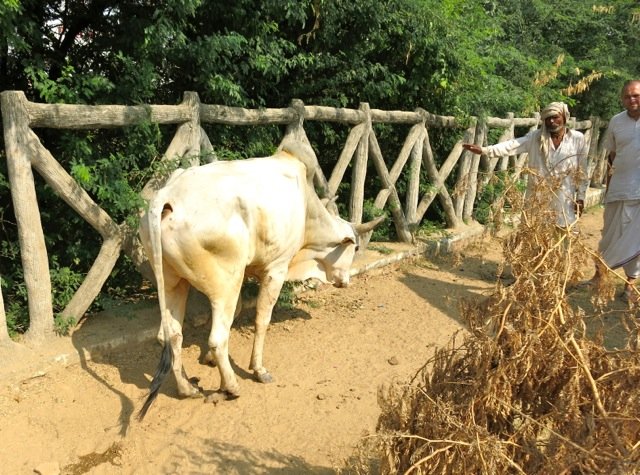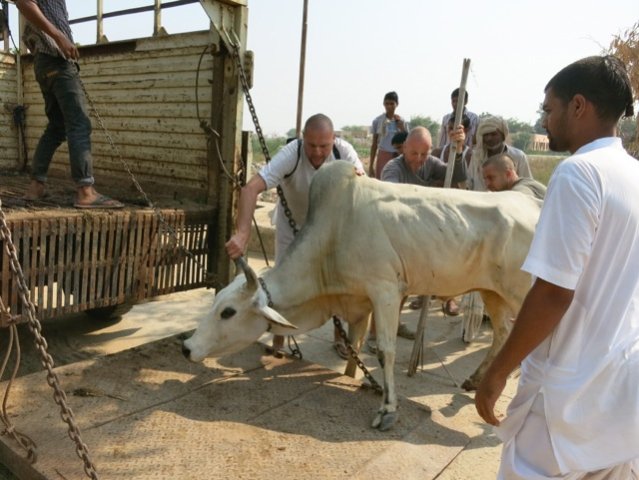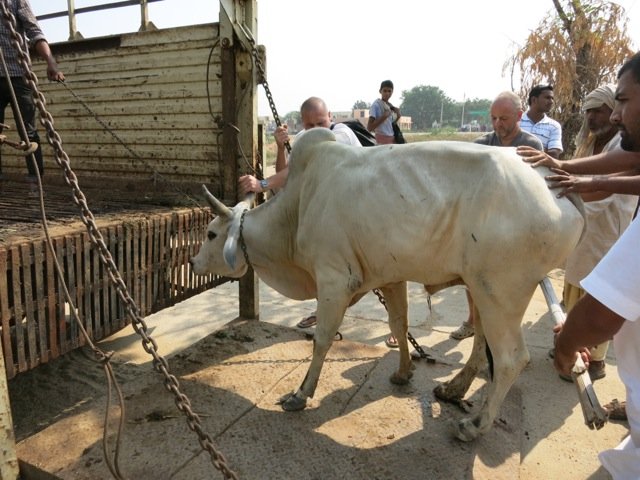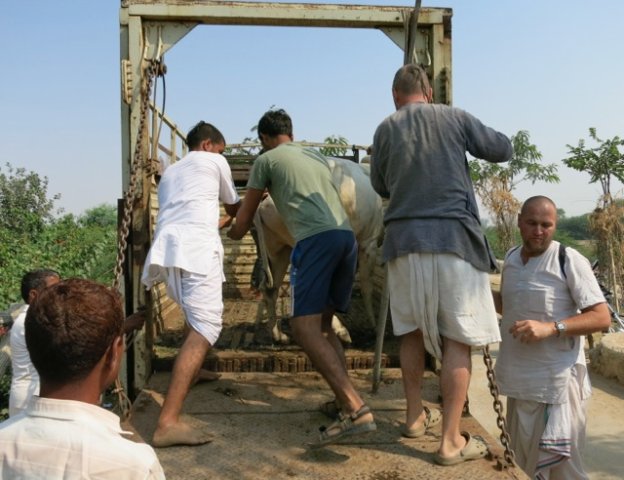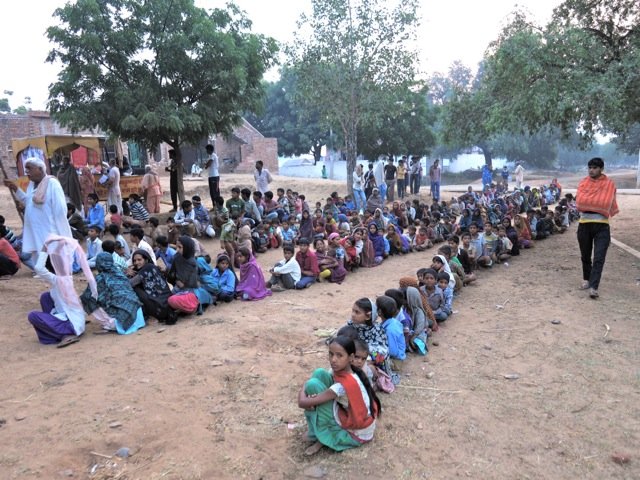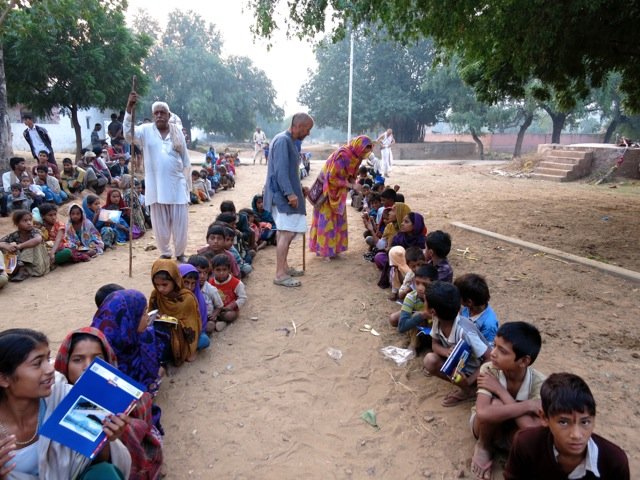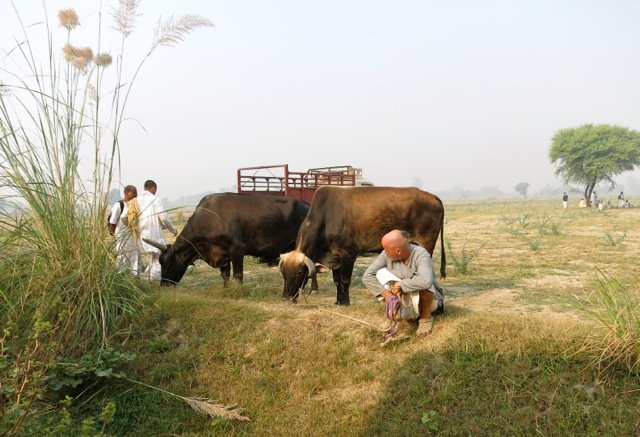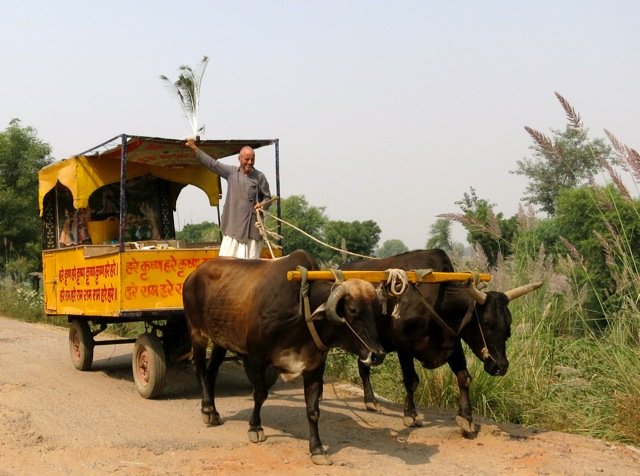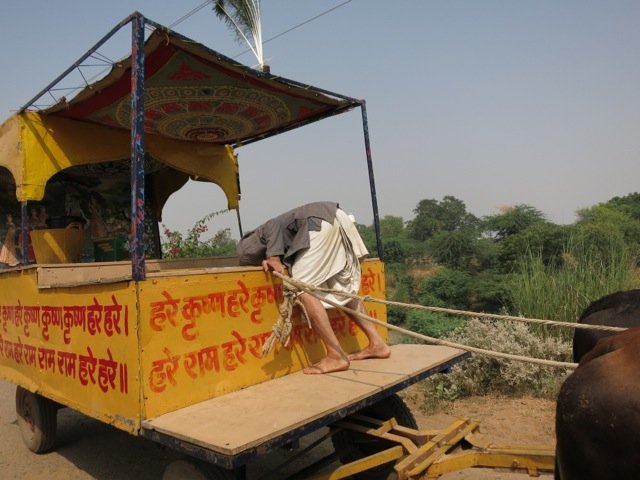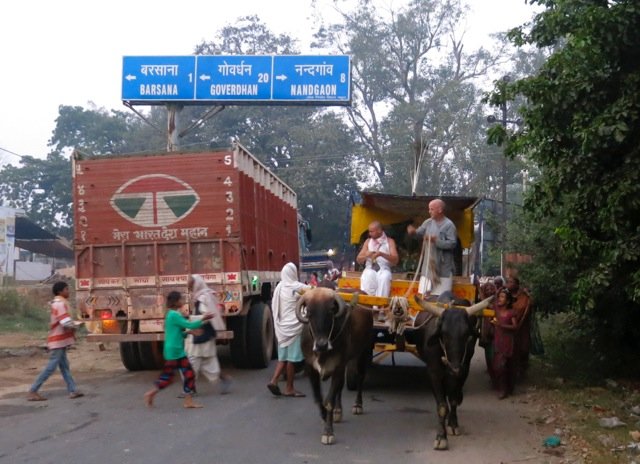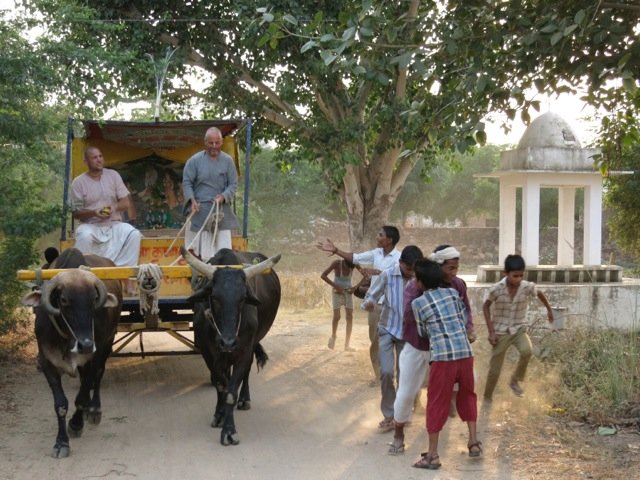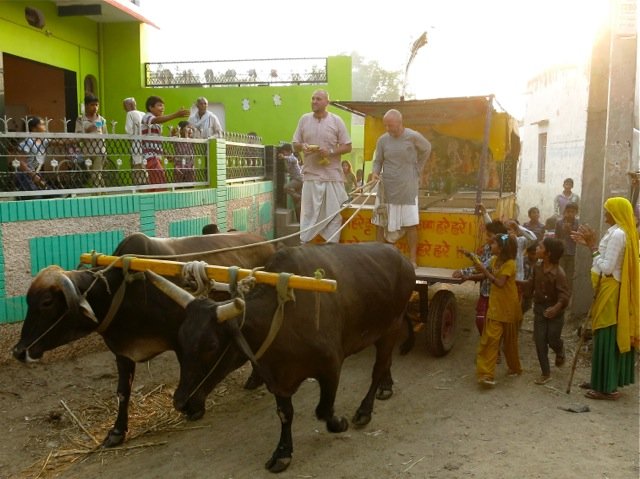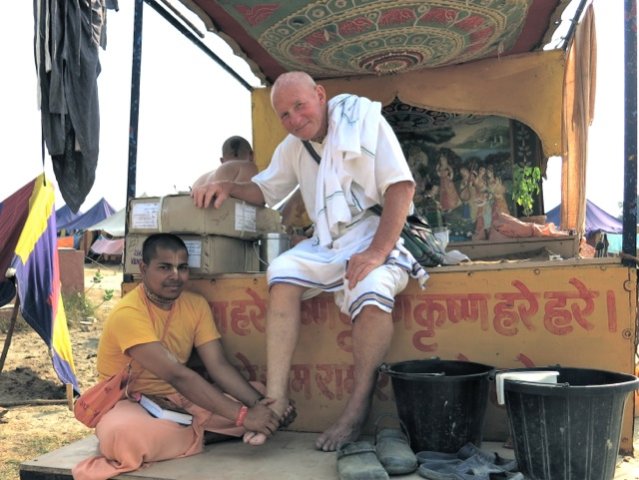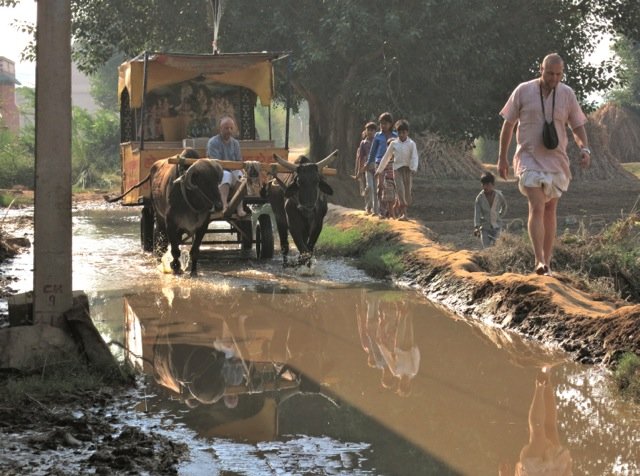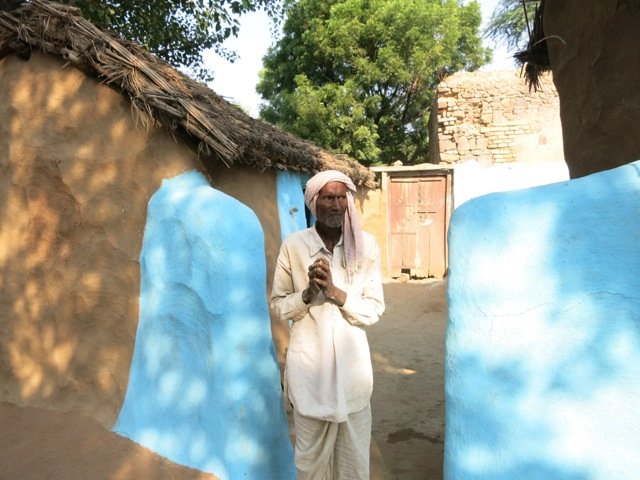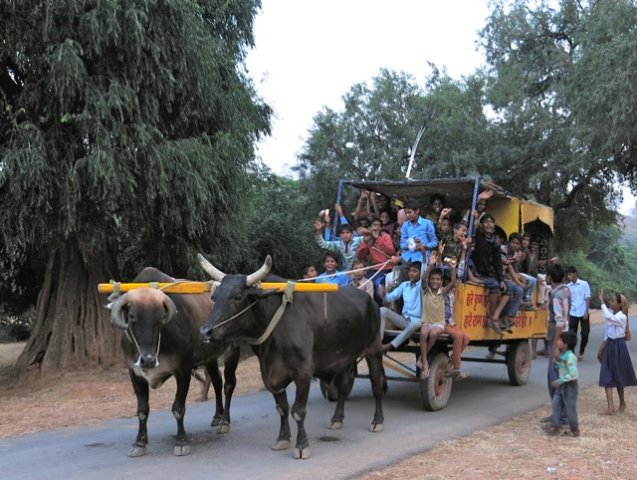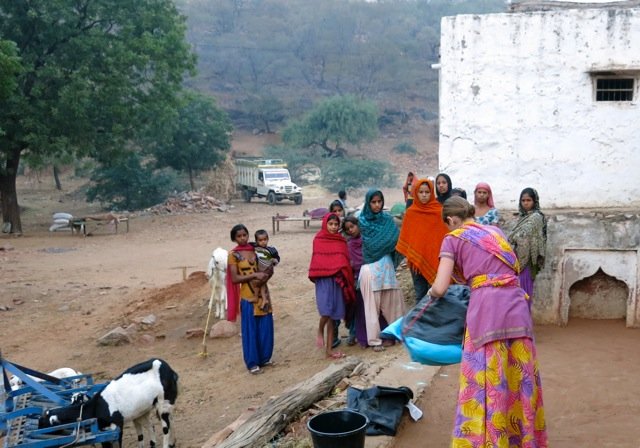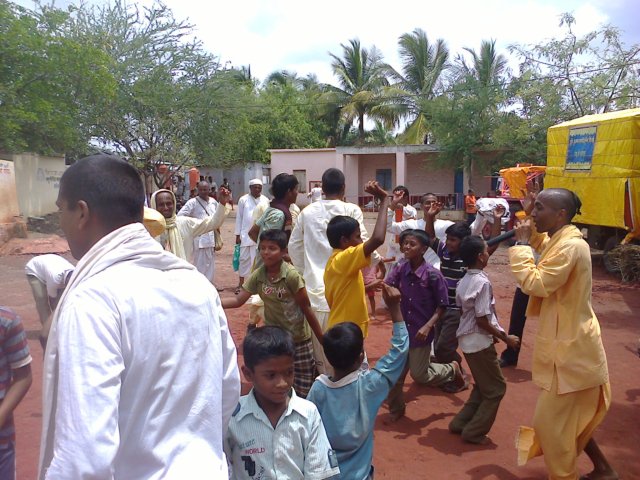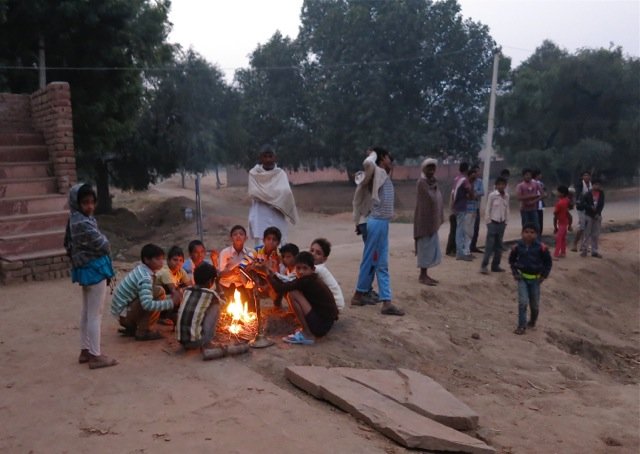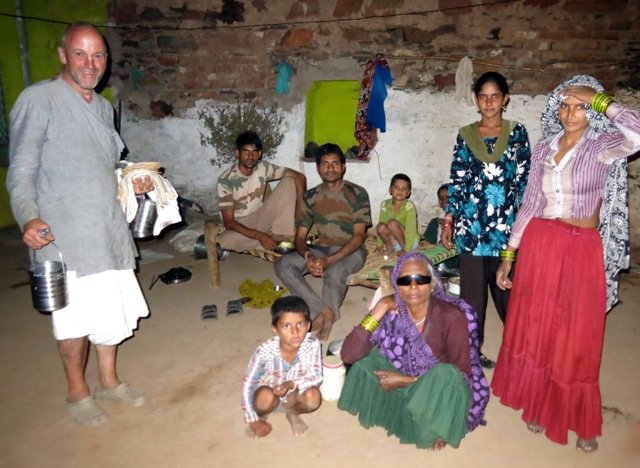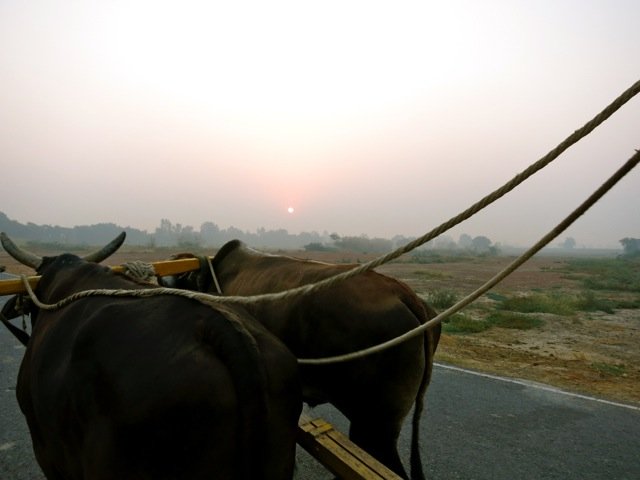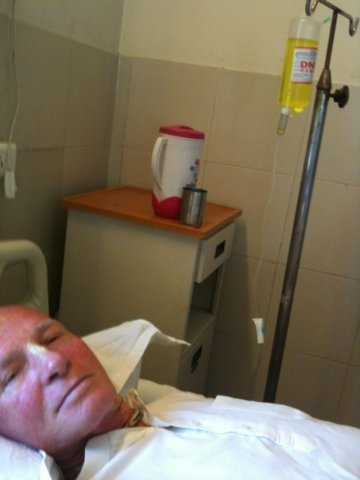A dynamic international party
The 28th Vraja Mandala Padayatra/Parikrama started on October 8th, 2014 at the same place and time as the annual ISKCON Vraja Mandala Parikrama led by Lokanath Swami and his team. As usual this Vraja padayatra was led by Parasurama , an Irish devotee living in the UK, assisted by an international team. There was Arjuna and Krishna Mayi from the UK and Estonia, veterans of 12 and 8 padayatras respectively, Loka Saranga and Madhu Pandit from the Czech Republic, Vaikuntha Vijaya from Russia and myself from the US. Parasurama organized the whole thing, he drove the oxen the entire time, distributed prasadam and books, guided and patiently engaged the rest of us. He certainly fits the description of the busy person mentioned in this popular saying “If you want something done, ask a busy person, as he’s always got time to do one more thing.” Bhakta Charles from Vrindavan and Vanamali Govinda also joined us for the first week along with Abhay from Mayapur, who strayed from the ISKCON Parikrama Party to join us from time to time. He’s a sweet young devotee who has a lot of experience with oxen, and he leads nice kirtanas. In total we were five grhasthas and five brahmacaris.
For the first few days going through Vrndavan and Mathura we would camp with the large ISKCON parikrama party (around 1,300 devotees) but we would go on our own to distribute bananas and booklets. In general we would come into their large camp to take prasadam and spend the night. As we entered the countryside we went more and more into small villages that the padayatra had visited over the years. There we would have kirtana and show our movies at dusk. At times we would spend the night in the villages or on the outskirts. Generally we would not be far from the ISKCON Vraja Mandala Parikrama group, travelling like them through the twelve forests of Vraja.
Adventures with the oxen
Our party consisted of an 18 year old oxcart graced by small Gaura Nitai, Lord Narasimha and very small Jagannath, Balarama and Subhadra Deities. Meena, the ox with downward pointing horns – which apparently is auspicious- and Narottama, with a beautiful set of large horns, were the driving force. Both were veterans who’d done this service over the years. The cart was definitely showing its age. Before we left Vrindavan, Nekram Prabhu put some yellow paint on it, changed the wheel bearings, pumped up the tires and gave the cart a thorough washing, but the frame has serious rust problems so the cart will need to be replaced in the near future. Parasurama has a battery system run by solar panels on top of the cart. It was malfunctioning so we had to resort to alternatively charging the two large onboard batteries that power the sound system and movie projector. On the back of the cart is a large picture of a smiling Srila Prabhupada, and the maha-mantra in Hindi. The back inside of the cart has a beautiful Krishna lila picture, and on either side of the cart is a large Hare Krishna mantra in bright red.
It’s always an adventure being with Parasurama. Sometimes you feel that everything is happening on a wing and a prayer. In others words things aren’t entirely prepared but you’re hoping they’ll succeed. Usually you do a lot of praying and really have to depend on Krishna. For me as a first-timer it was a wonderful adventure. I’ve survived and relished two Scandinavian Ratha-yatra Tours with Parasurama and crew so the padayatra was the next step, an equally challenging and interesting experience. Our oxen come from the Krishna Balarama Mandir goshala. Parasurama tries to pick ones that he’s had good experience with previously, but they’re not always available. So sometimes it’s hit or miss. At one point we had to trade our black and white ox as he was constantly making unsolicited left turns, sometimes into traffic, vendors stalls, and parked cars. Parasurama had to constantly remind me not to pass too close to him lest I get gored. He had this look in his eyes that said, “I’ve got to find my way back to the goshala.” Maybe he was pretty smart after all, and he got his wish.
The original oxen were shod at the goshalla in Vrindavan, but when we traded the black and white ox for another, the new one needed to get shod, as walking on the pavement and gravel roads are hard on their hooves. Now that tractors are replacing oxen for farm work, there are fewer men who shoe oxen, thus it took a while to find one. The man uses a strategically placed rope to gently bring the ox to the ground and into a position where all four hooves are accessible and then proceeds to nail the iron shoes on. It was a little stressful on the ox as it was blazing hot but Parasurama was sitting at the ox’ head, soothing him.
A funny sight was Parasurama steering the oxen and distributing bananas and books at the same time, which led to a few near misses. Luckily Indians are used to this and nothing untoward happened. Thankfully the bullocks have an automatic pilot feature built in, and they just plod along when Parasurama has his back to them and half of his body digging deep into the bin of bananas.
40,000 books, 9 tons of bananas and some hard hitting movies !
Each year Parasurama prints 40,000 small books, thanks to Bhima Prabhu and the Mumbai BBT.
On the average we distibuted 300kg of ripe banana prasadam every day, which in a month adds up to 9000kg (close to 20,000 pounds). The bananas and books are all paid for with donations that Parasurama secures over the year. Pretty amazing! When we arrive in a village with the oxcart, the Deities, the books, the bananas and the harinama, it’s like the circus has come to town. It’s a big sporting event for the children. They get very excited, climb on the cart with great joy (once a large group of children was trying to topple over the cart) and, very enthusiastically, fight for the banana prasadam. That’s why it’s easier to throw the bananas rather than individually hand them out. The adults get into it also, but it’s all done in a good spirit – no violence or nastiness. Everyone’s very happy, except maybe a few of the real small kids that didn’t get a banana.
Every year Parasurama also makes a hard hitting movie which covers topics such as cow slaughter in India, the illusion of material happiness, and the importance of Krishna consciousness. It’s in the Braj language, so it definitely hits home. Before that movie we showed the Little Krishna Series.
This wonderful padayatra service brings to the villagers of Vraja a much needed personal interaction with ISKCON devotees. Sadly, some of the large and small ISKCON parties come to the places of pilgrimage, in or near the villages, but don’t interact with the local villagers, besides taking photos of them and discarding garbage by the wayside. There’s not many personal connections. Over the years Parasurama has developed nice relationships with so many of the villagers. He brings out the Krishna consciousness in them and their children. We give freely and don’t expect anything from them in return, which has a profound effect on them. Then they become very anxious to render some service.
In the evening I was going out doing madhukari (begging prasadam from door to door), usually in pitch black, as the majority of the small remote villages don’t have electricity. I was very humbled to see how the brijbasis were very happy to give us rotis, dal, buttermilk and dahi (yogurt). Once we saw a well with a sign attached to it saying, ‘With love from Rajan, Anju, Nalin, Anshul, Chadha from London UK’. Parasurama explained that these devotees had donated laksmi to have this much needed well built in the village. He’s the one who had it built and put the sign to honor these generous devotees.
Close contacts with the Brijbasis
Everything we did, whether it was the mixing of the oxen’ food, cooking, bathing, sleeping, and so on seemed to fascinate the villagers. Some of the villages were very remote and rarely visited by foreign devotees so we became the biggest show in town. They would be there at night as we pitched our tents and when we woke up they would be waiting for us. It could be a little unnerving but they were mostly very friendly and harmless except for a couple of the village punks whose only way of getting attention was to do or say something foolish. In most of the villages that we crossed, villagers would come out and feed our bullocks grains as a sign of appreciation. They really see them as the symbol of religiosity, and they are dependent on the cow and the oxen for their livelihood and maintenance. I was very moved by this exhibit of reverence for father bull.
One day we passed through a larger town and the teachers came out to invite us in their school. There were at least 20 classrooms of different levels and ages. The children were well behaved and joined in reciting the maha-mantra and enthusiastically took part in kirtana. They chanted Hare Krishna like pros. We distributed notebooks, pencils, bananas and booklets. I especially liked the baby class. It was such a wonderful experience. So sweet and happy! Again the simplicity of it all is heart warming. You don’t need so much to be happy!
A few scary moments
Once we had a few very scary moments. I was up front doing kirtana when all of a sudden there was abig commotion and a lot of shouting. One big white bull had charged our oxen, knocking anyone in his way, getting things flying around, including a few kids. Happily no one was hurt or injured. This white bull was the head of this small village; he really was a beauty, big, strong and powerful, and very territorial. The villagers are probably used to dealing with this type of thing, but Madhu Pandit was not. He grabbed a large bamboo pole and fearlessly went after the bull, who reluctantly retreated, and was then quickly fended off. I will not forget the look he gave Madhu with his big red eyes.
Another time, as we were walking to one of the bathing ghats we were summoned by some devotees who needed help rescuing a young bull who had a broken foot. He was very fearful and undoubtedly in a lot of pain, so he resisted attempts to be led to the awaiting truck that was sent from the animal shelter. After some effort and close calls of getting hit with his sharp horns, the devotees, again led by Parasurama and Arjuna, held on to him and he was loaded into the truck. Everyone was very relieved and happy as the alternative was probably death for him.
Sweet but exhausting
When Parasurama advertised for devotees to join his party, he said they should be somewhat physically fit. Even at 71 I considered myself to be in good shape so I signed on. For me, with my pita constitution, the extreme heat was the biggest problem. We generally would walk from 3 to 20 kms per day doing harinama and distributing. It was exhausting at times but we always had a lot of water to get us through it. Sleeping out in or near the villages and the main parikrama, rinsing out our cloth daily and bathing either out of buckets or at the village wells, was just wonderful and exhilarating from my perspective.
Parasurama Dasa : What makes Padayatra special is you have about six hours of harinama daily, Deity worship, book and prasada distribution, preaching programs and cow protection. Vraja is Lord Krishna’s home, it is called Vraj Dhama or sometimes Madhurya Dham, and the sweetness can also be seen in the mood of the local people, the Brijbasis.
We stopped at Surya Kund, the place where Radharani would worship the Sun-God. It is a wonderful and long walk to get there and we distributed books and bananas to many villagers we met on the way. You really get a sense of sweet village life. Groups of ladies and girls carried water pots and cane on their heads while singing sweet songs, and men and boys worked the oxen in the fields. The temple is well maintained and the pujari very friendly. We slept inside the temple and bathed from the well outside next to the bullocks. Bathing in the moonlight next to dozing oxen while looking out over this beautiful Surya Kund gives you a beautiful taste of Vraja.
I was doing great for fifteen days, full of enthusiasm and strength, albeit, a little frazzled by the heat, but I came down with severe food poisoning after taking village food one evening. I was running a high temperature and every bone in my body ached and I had constant diarrhea. I struggled to make it to our next stop at Varsana where we had modern and clean facilities but it was too much; so I returned to where I was staying in Vrindavan. There my host saw my plight and took me to the Bhaktivedanta Hospital on the Parikrama Marg where I was diagnosed with a severe stomach infection stemming from the food poisoning. The doctor admitted me and gave me two bottles of electrolytes and a heavy antibiotic and anti parasitic and medicines for the pain and diarrhea. After four days some of the symptoms abated and my host gave me a small amount of banana, dahi and plain rice made by his wife. His father was a doctor so he had some experience. I decided to return to the US, 12 pounds lighter, not sure how long it would take me to recover in Vrindavana.
In retrospect it was one of the most wonderful experiences in my life. To be wandering the forests, villages and roads that were blessed by the lotus feet of Lord Krishna and His Associates is more than I can fully fathom. I know my sickness was due to my past and present sinful activities and was meant for my purification. My thanks go out to Parasurama for his amazing service to the Holy Dhama and for inviting me to take part in my small way.

